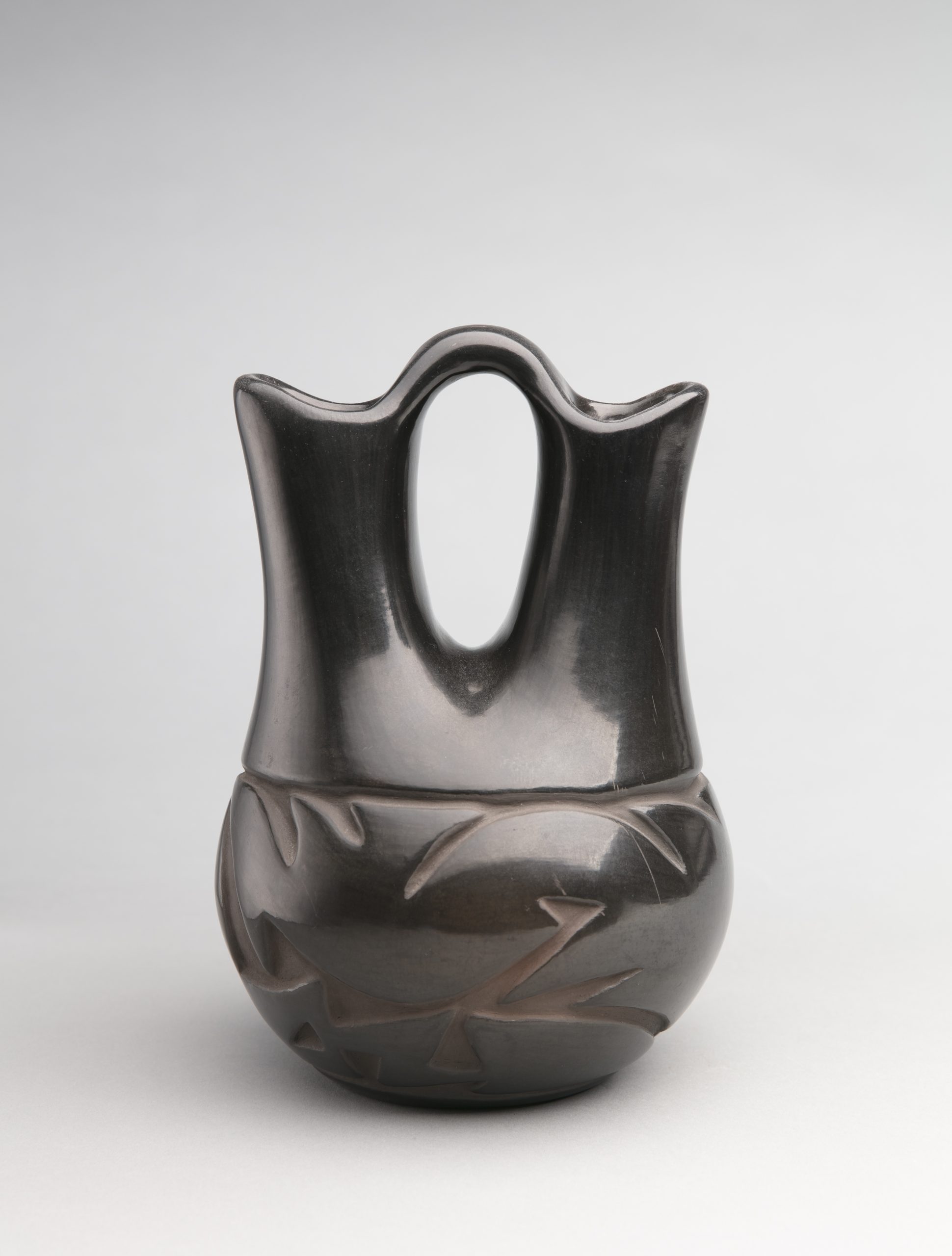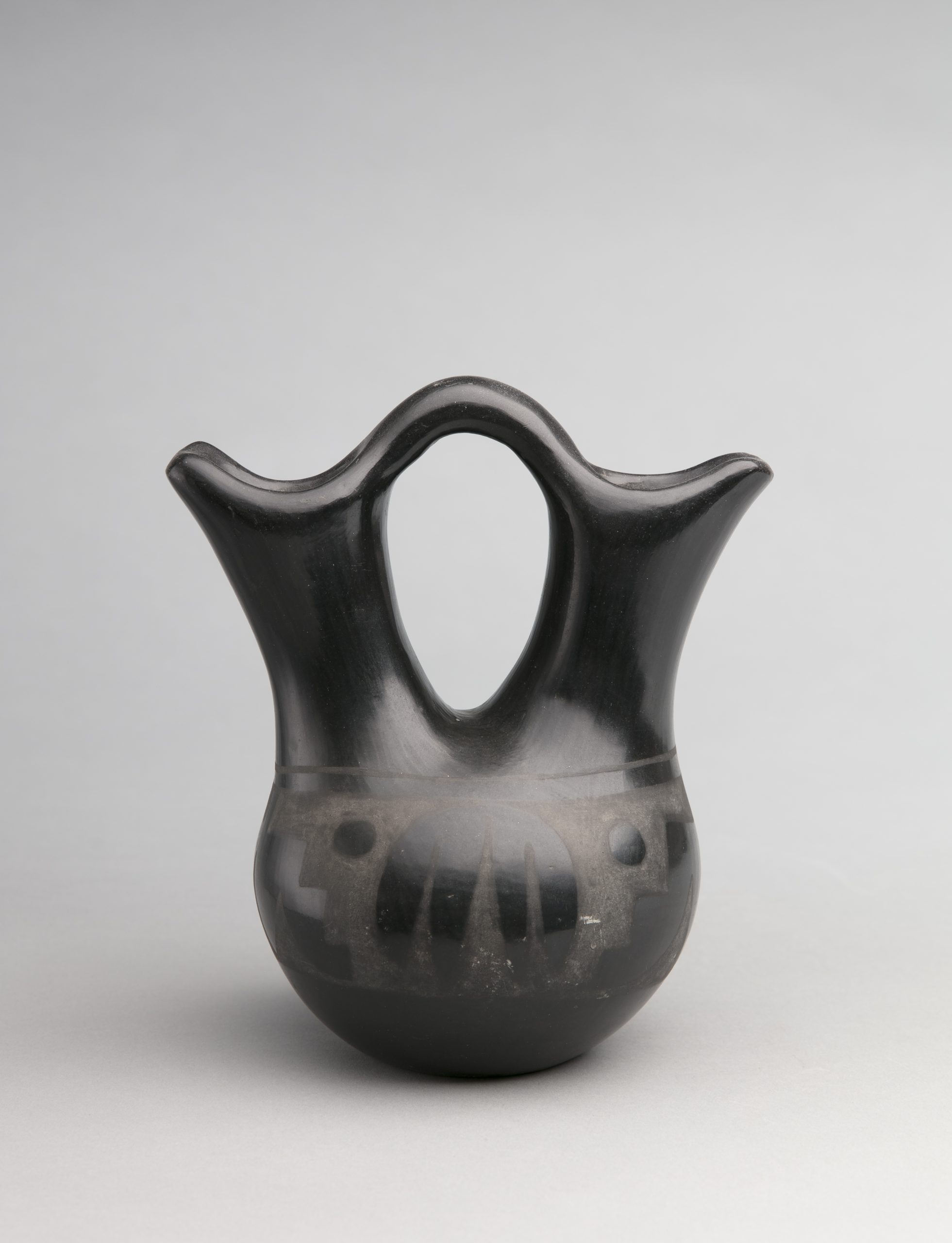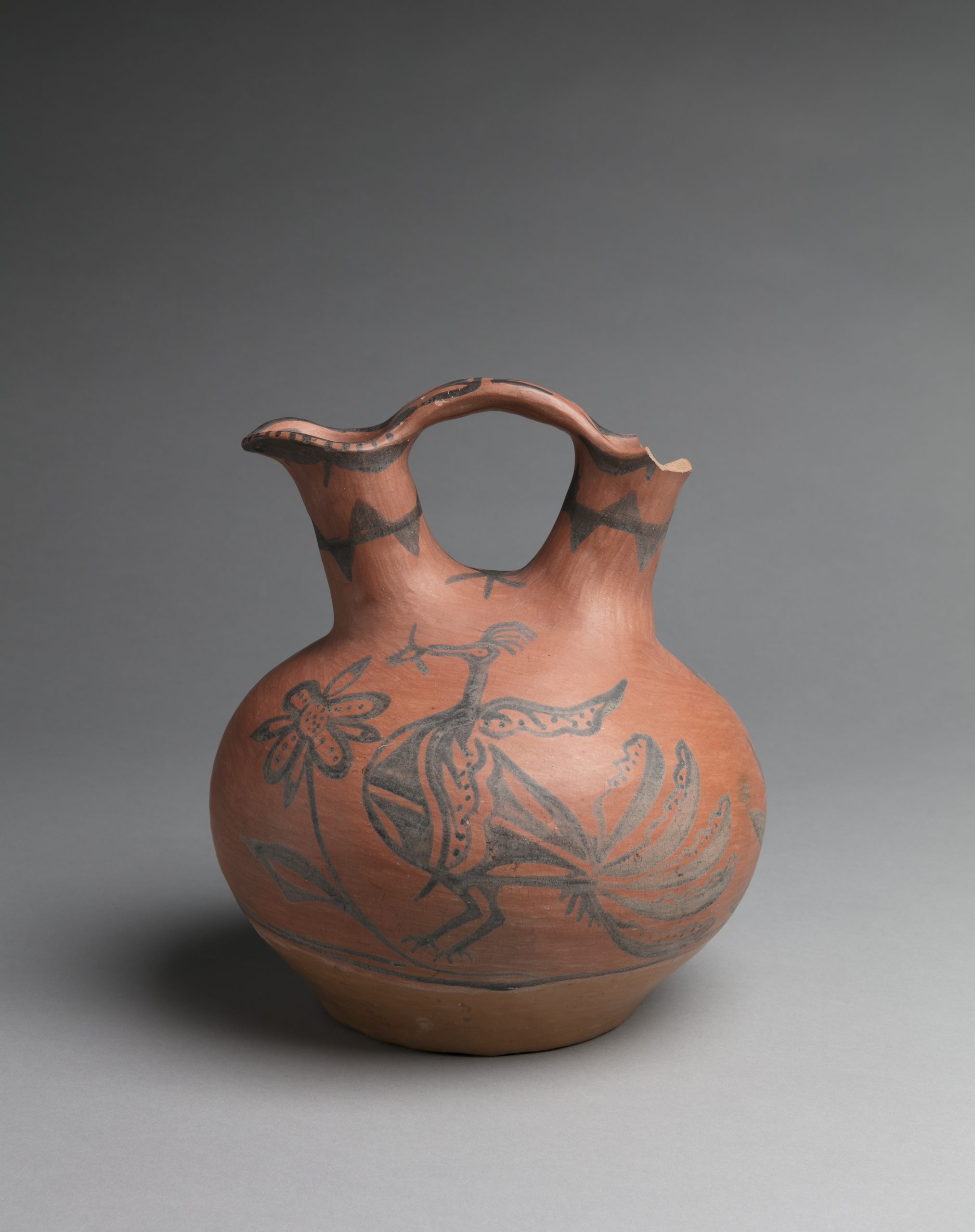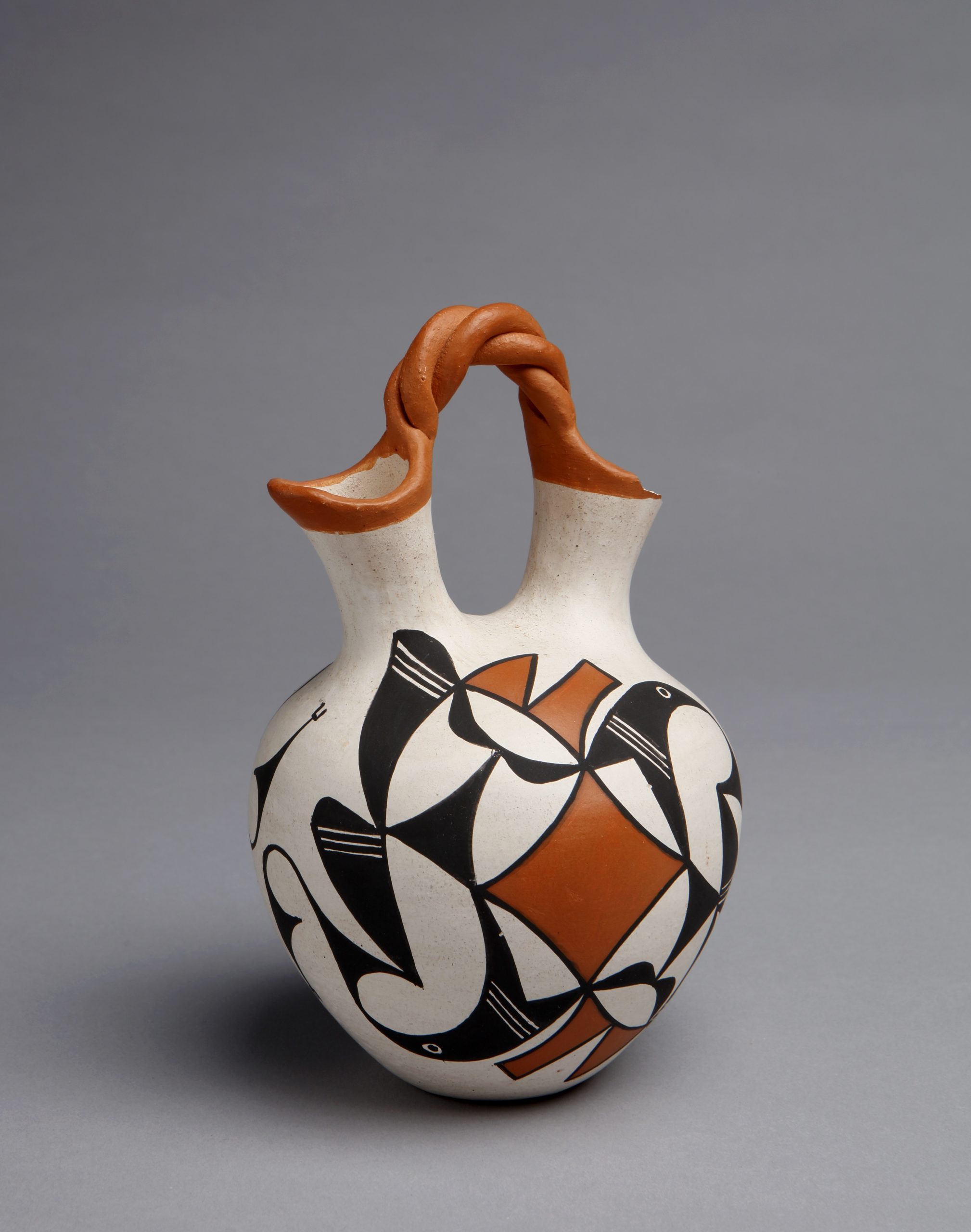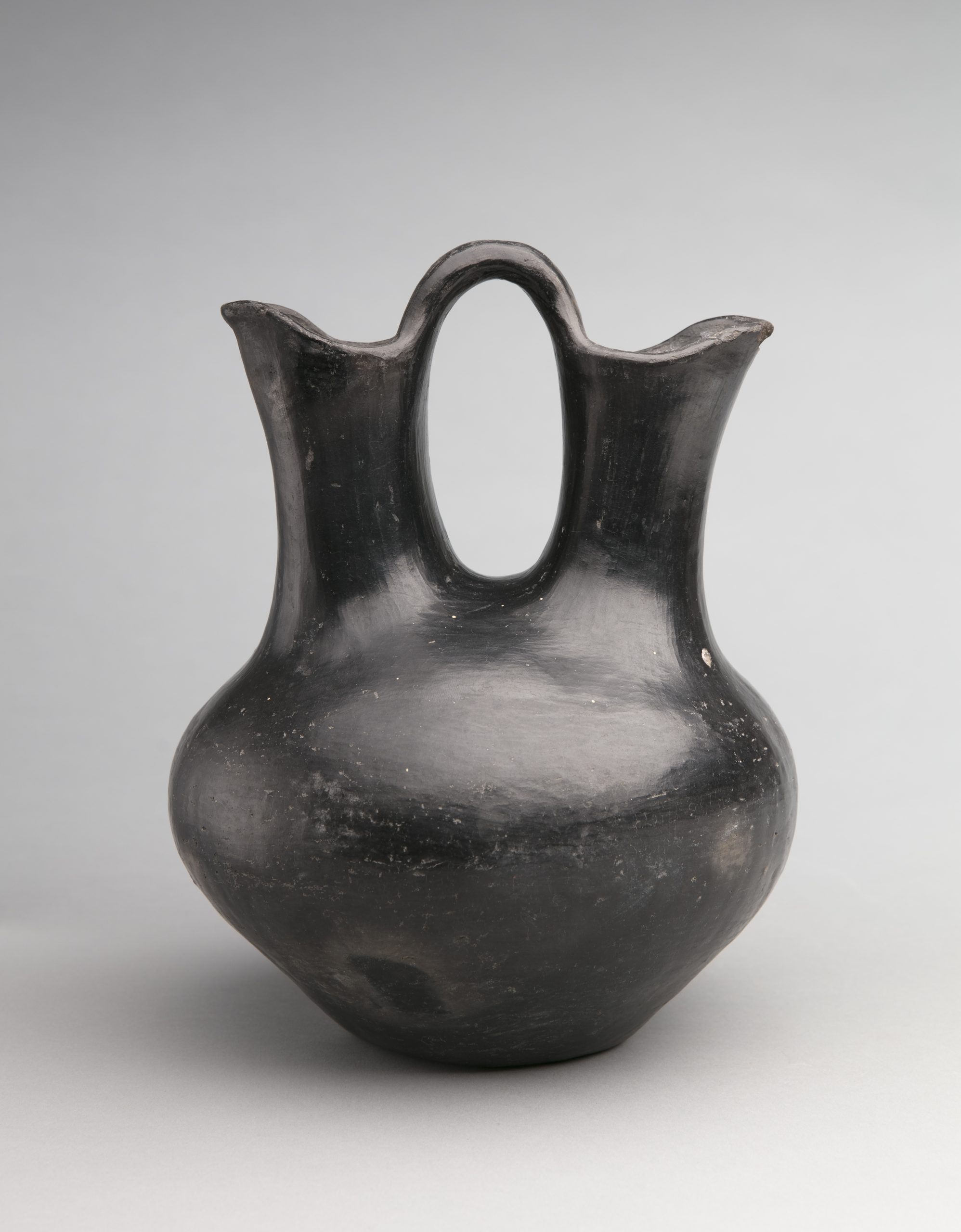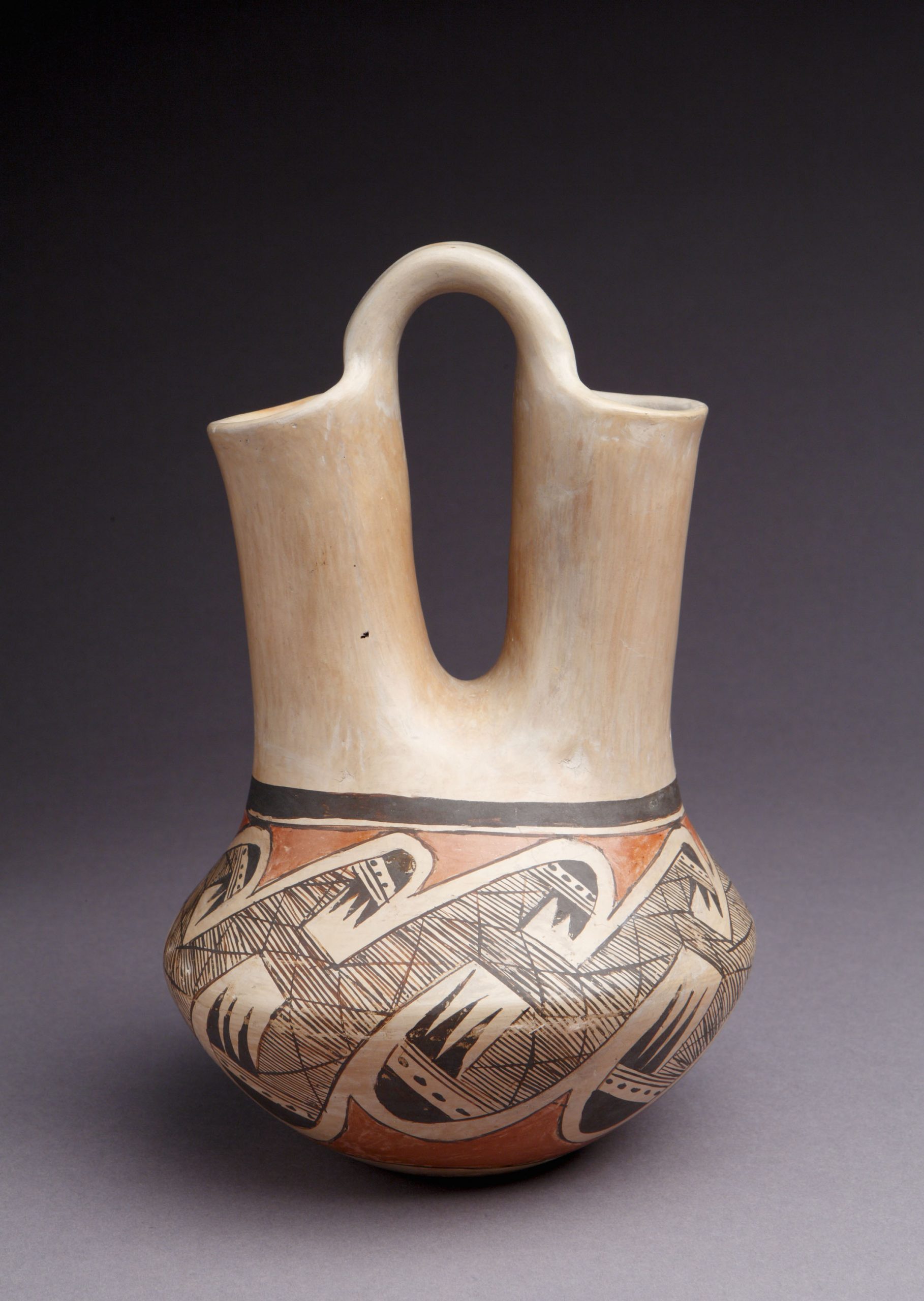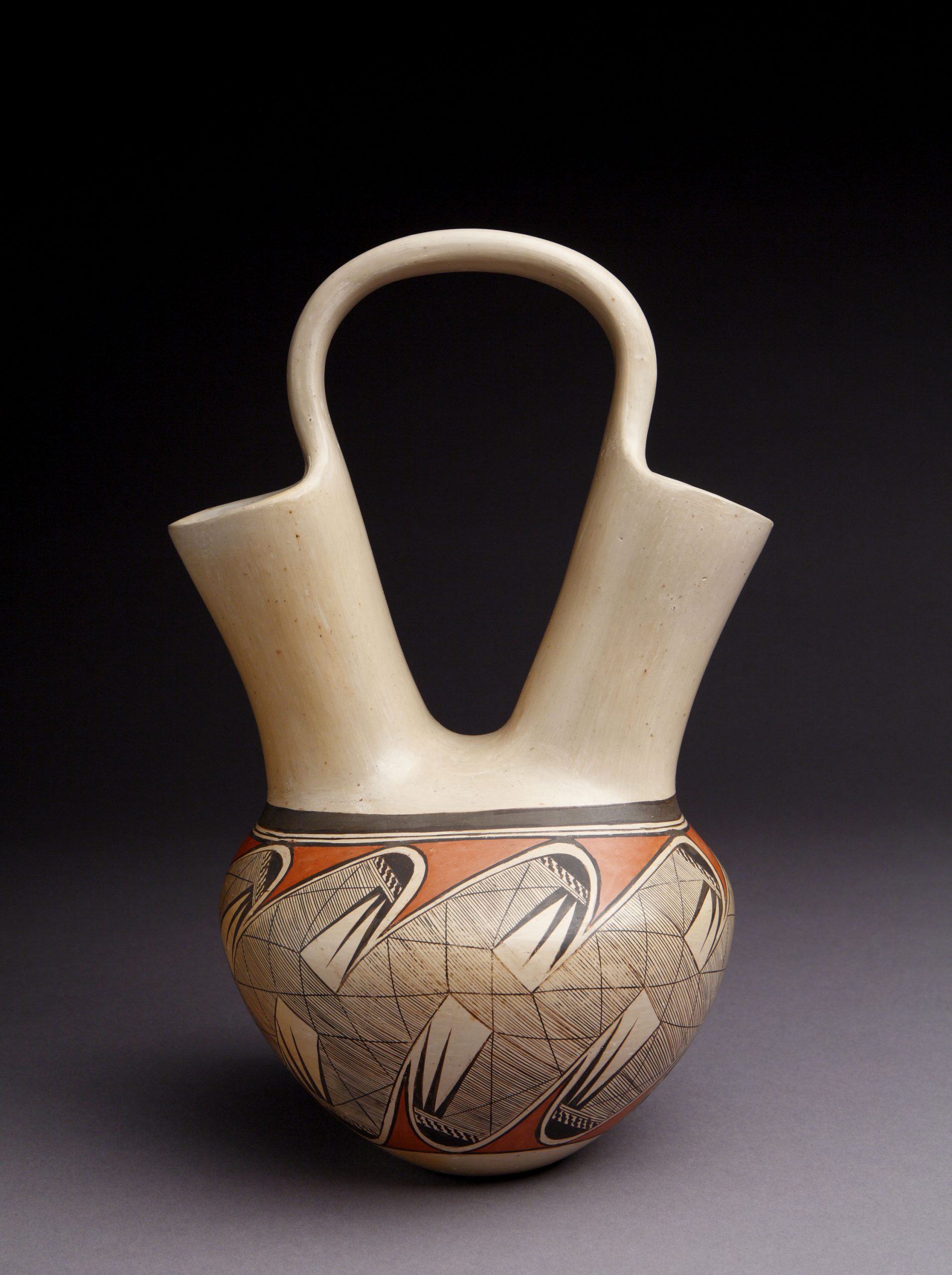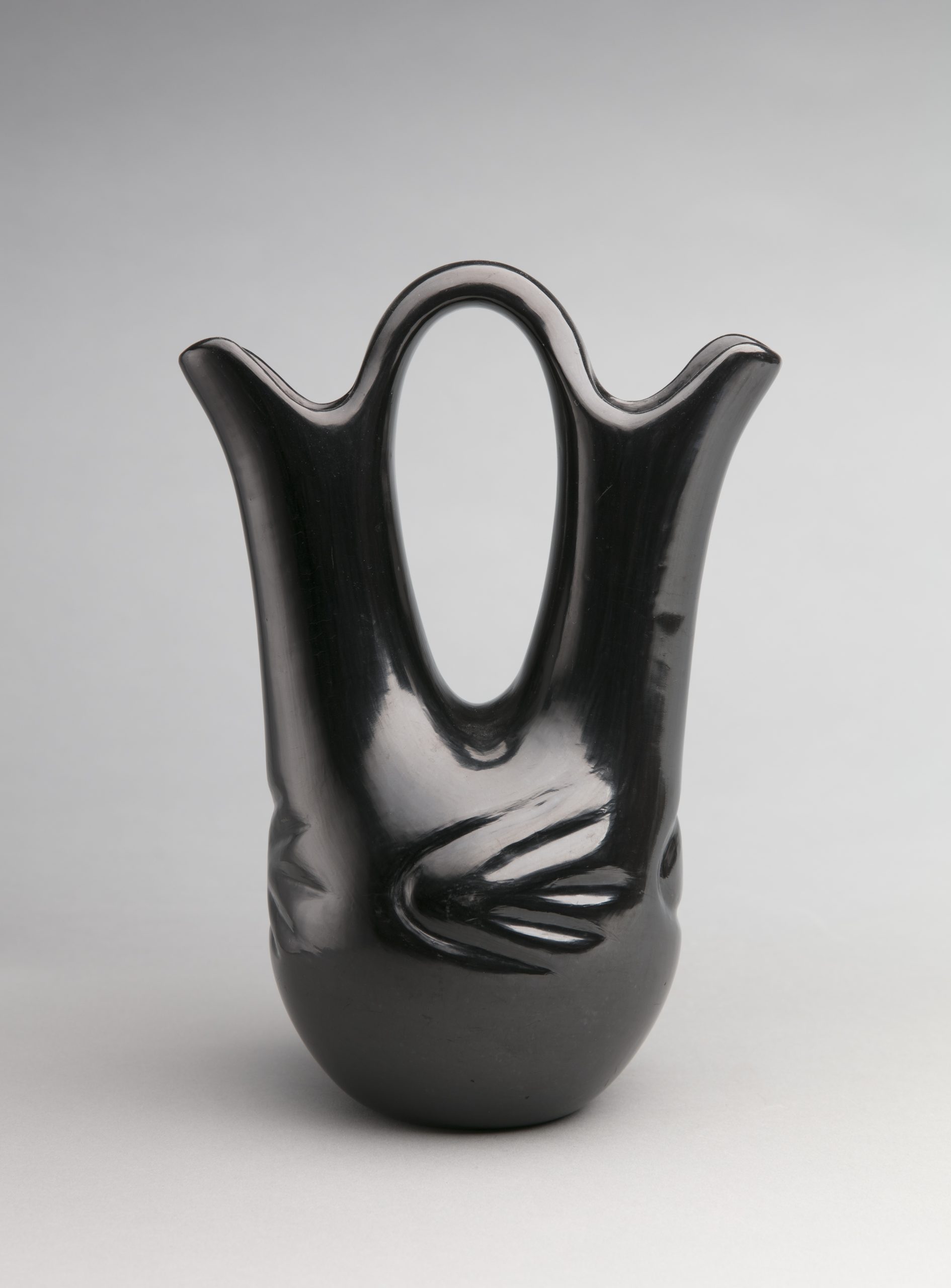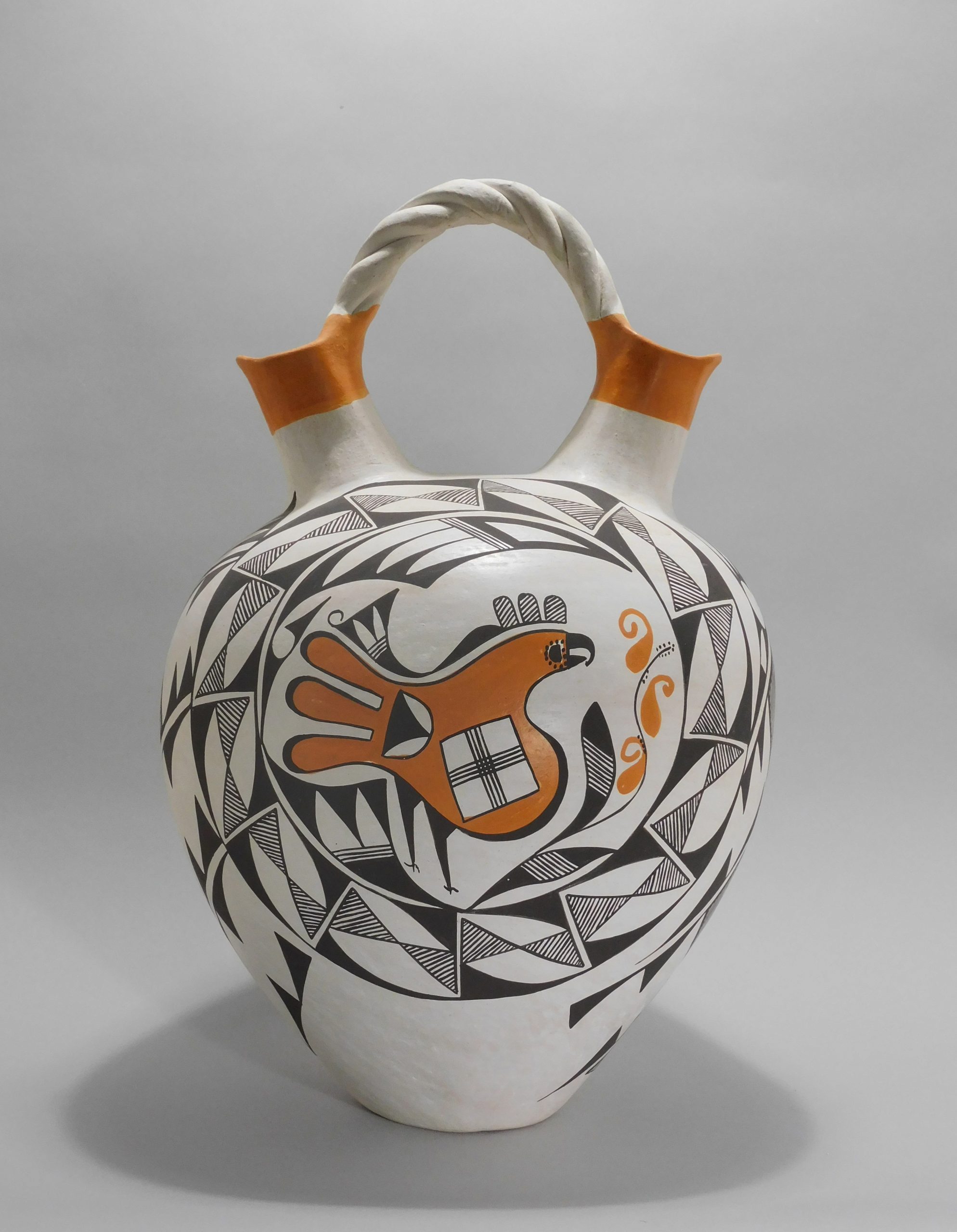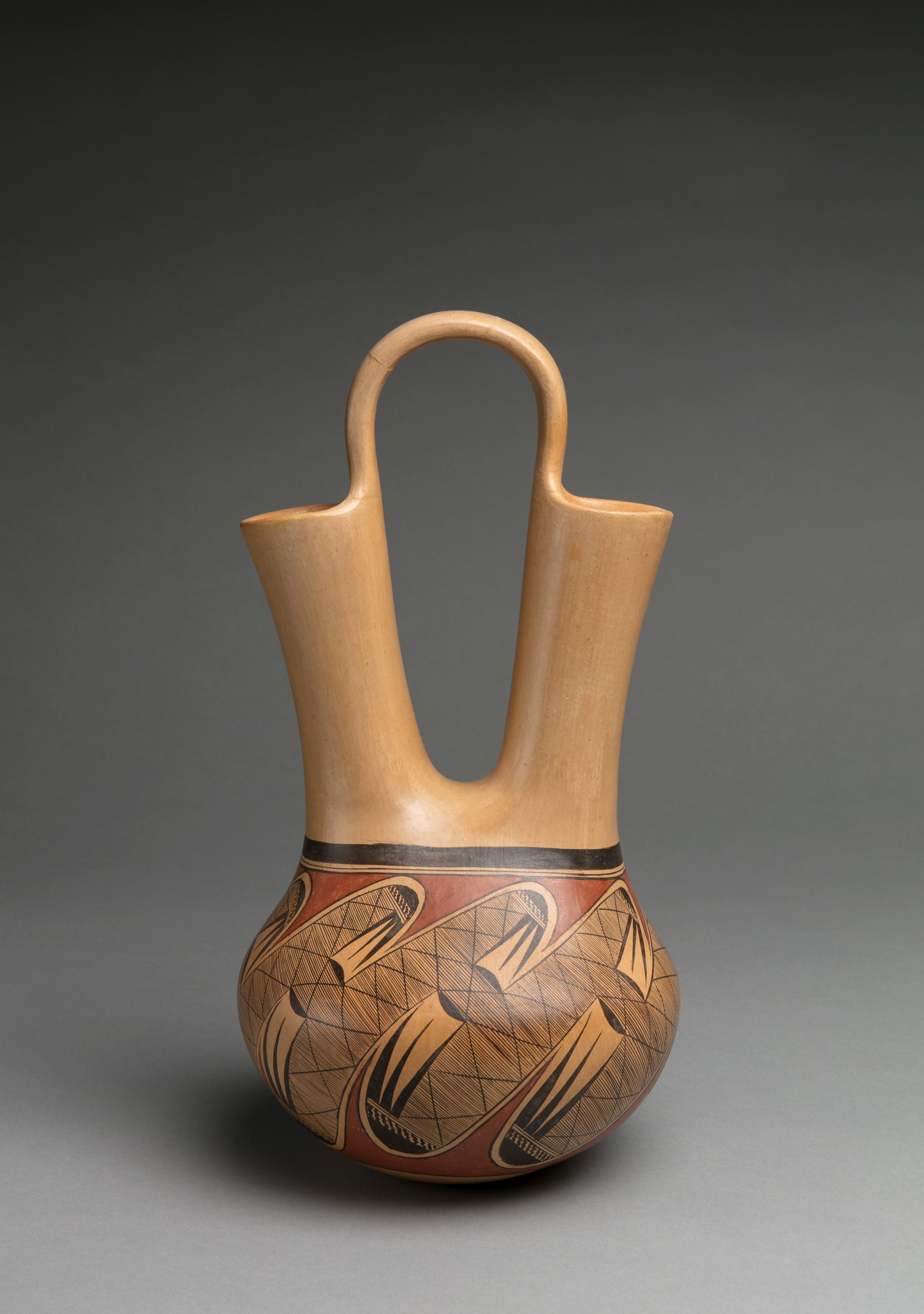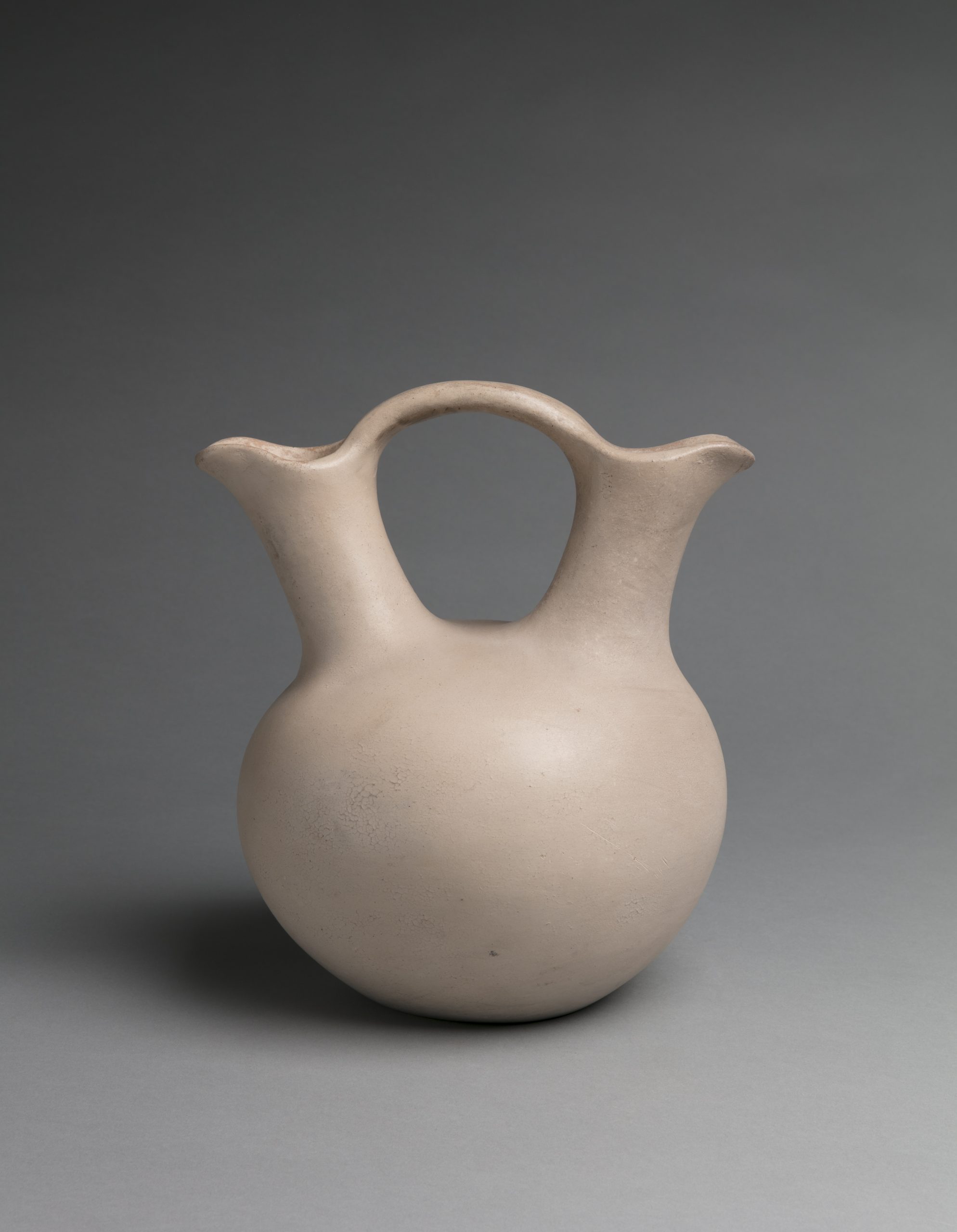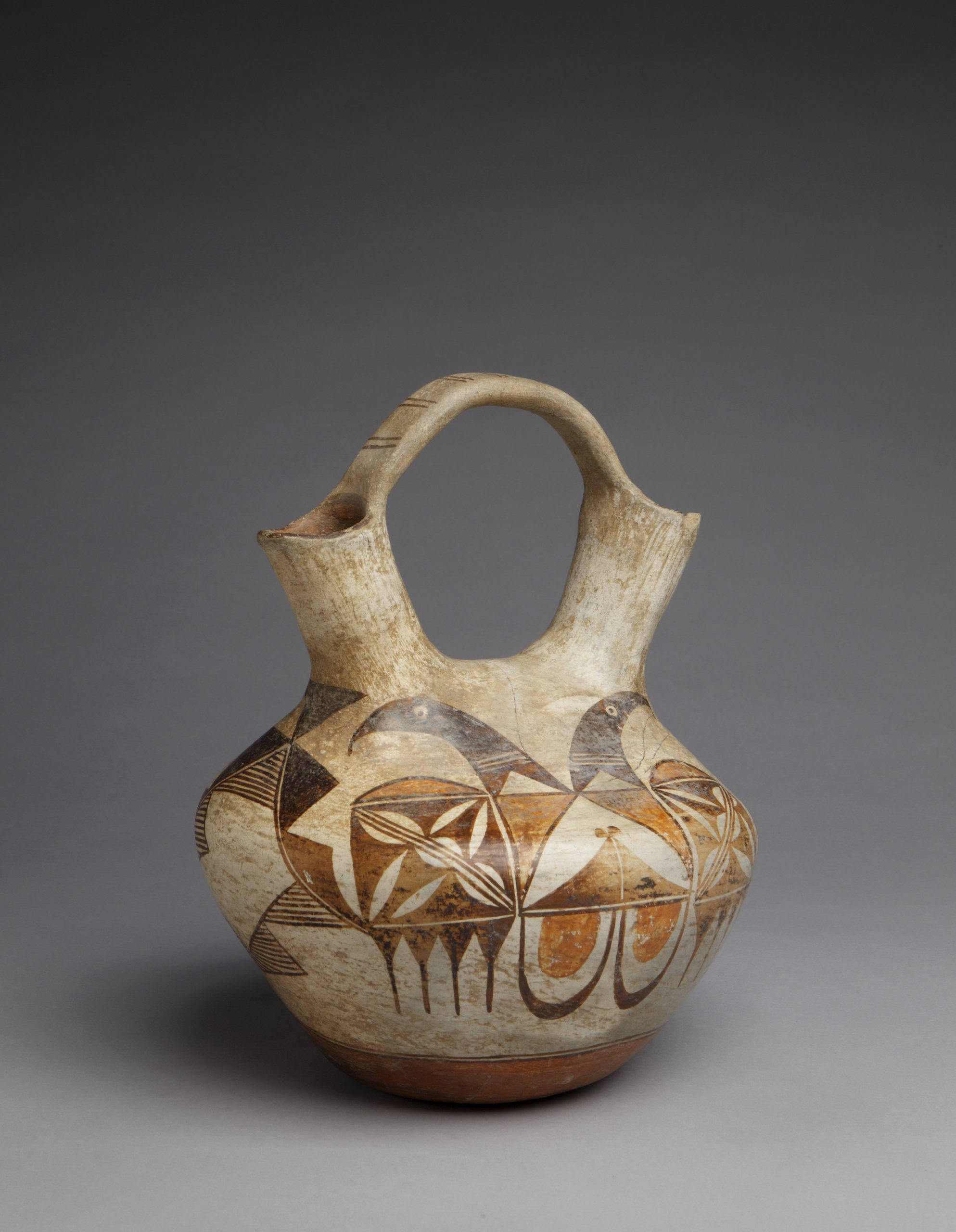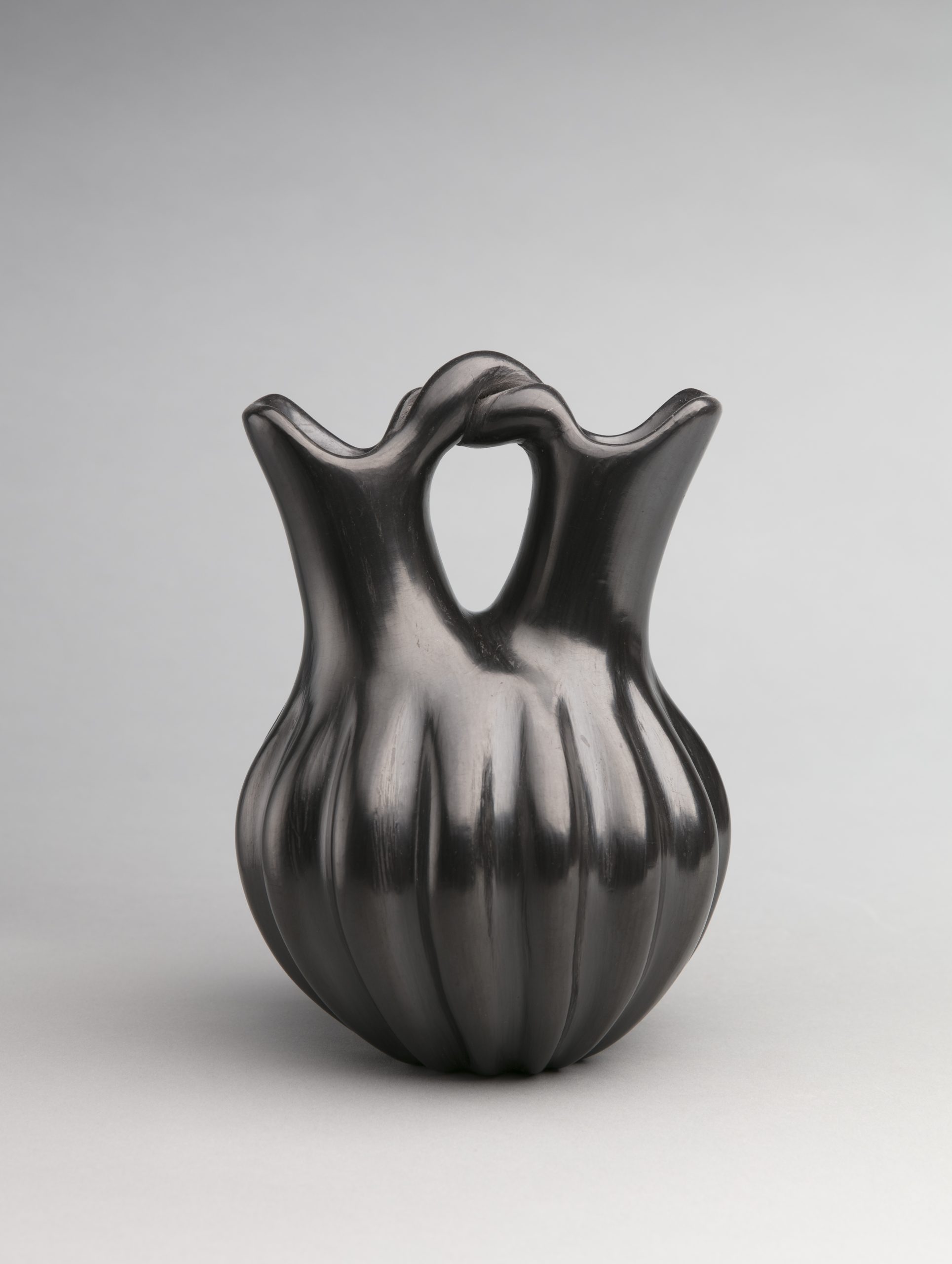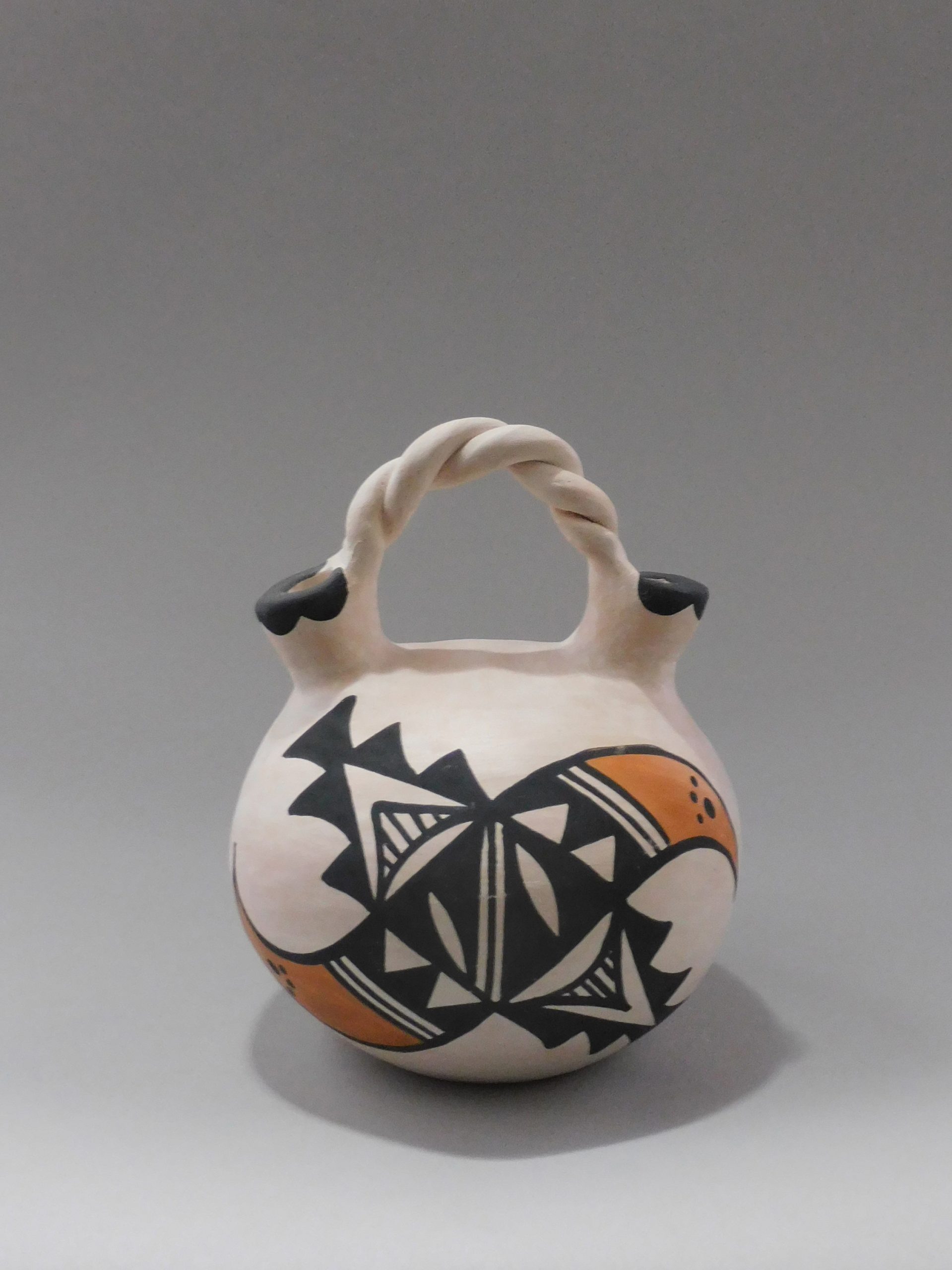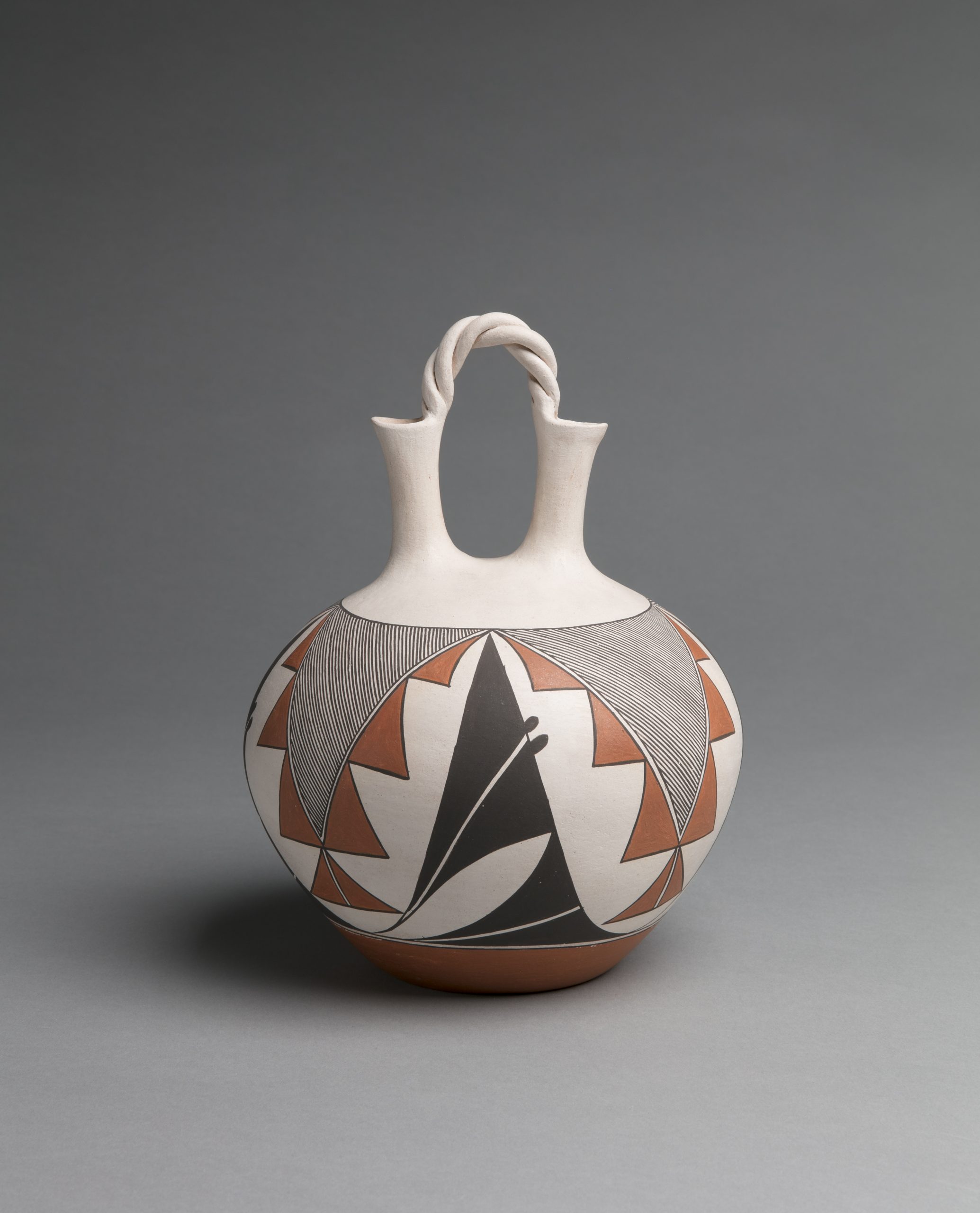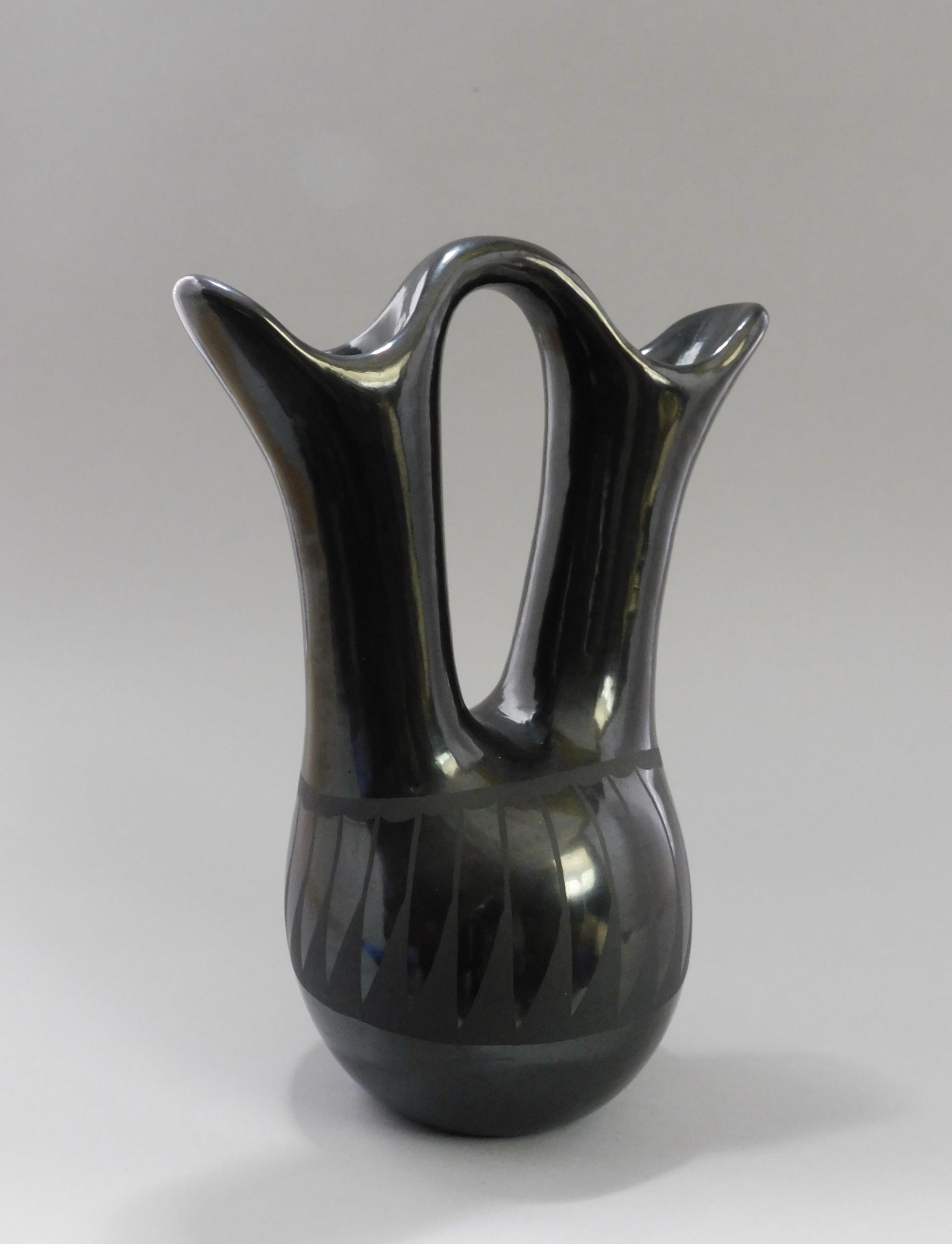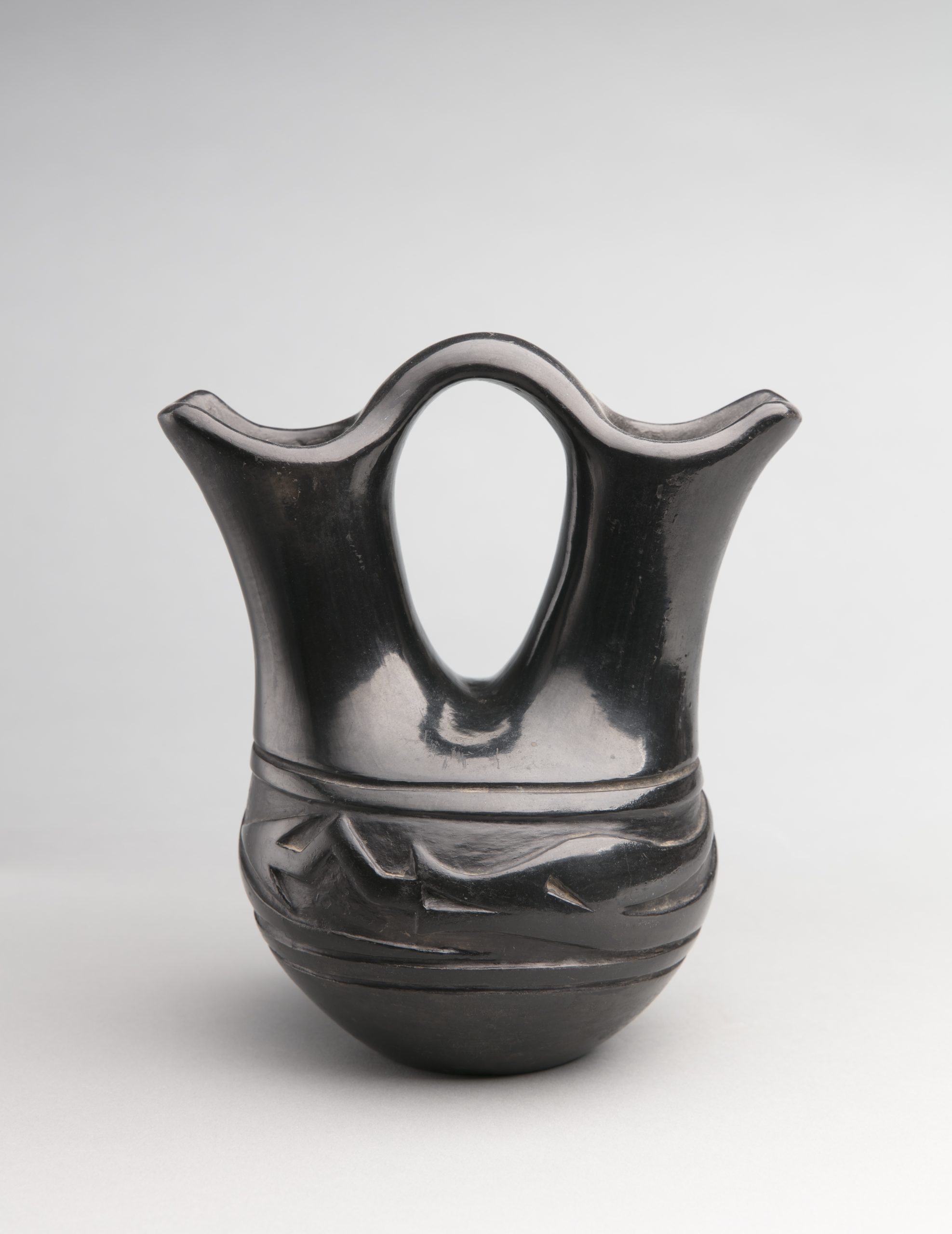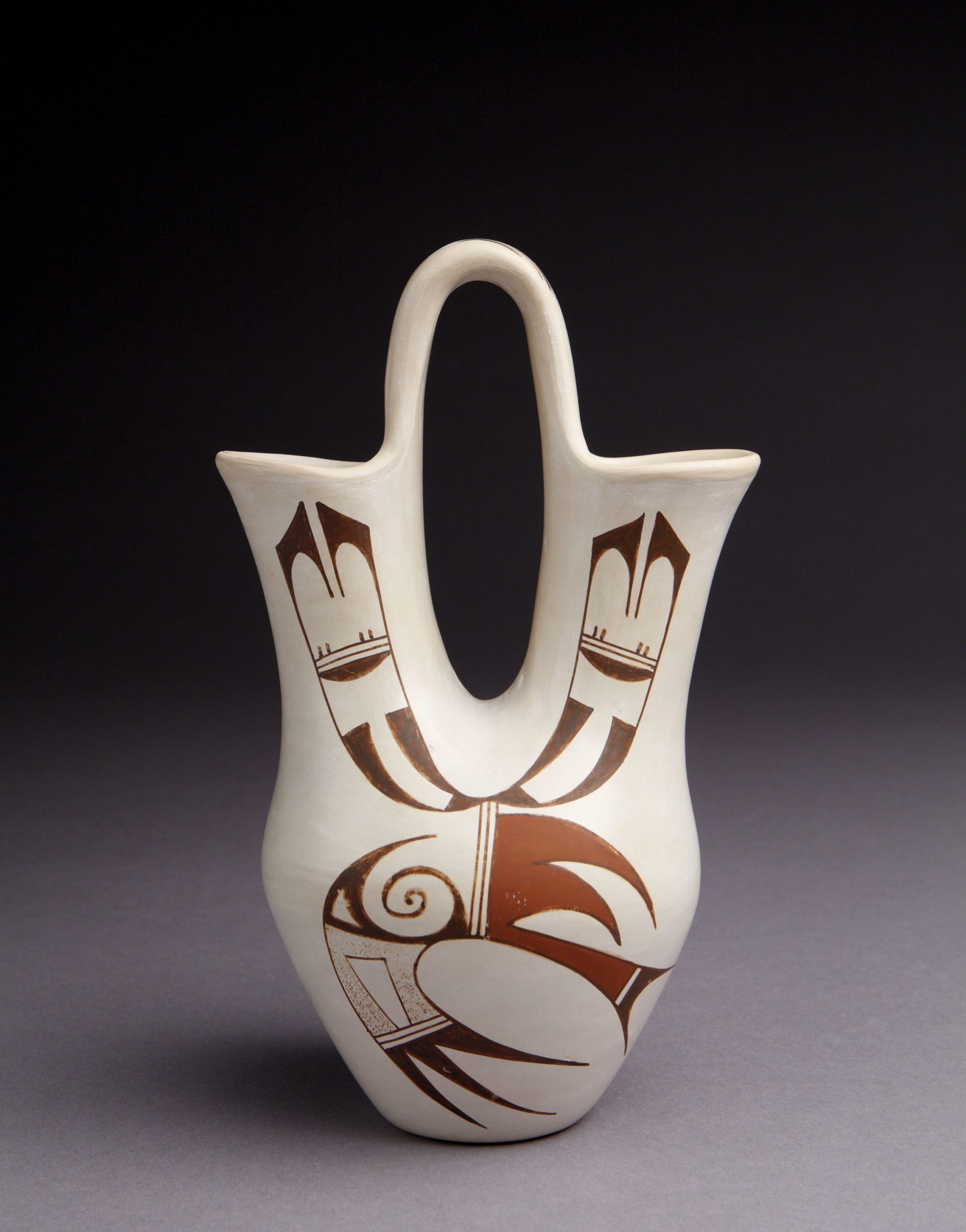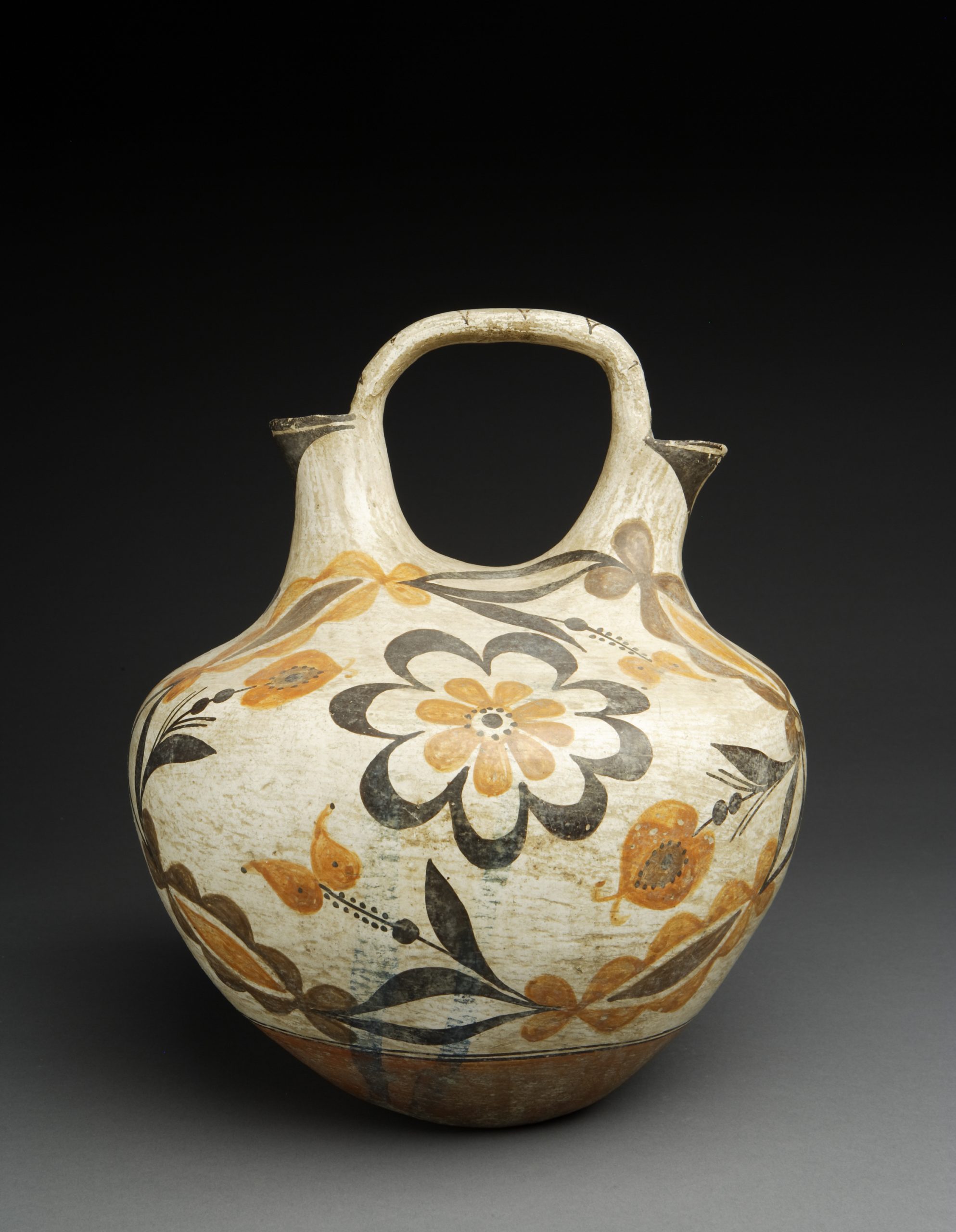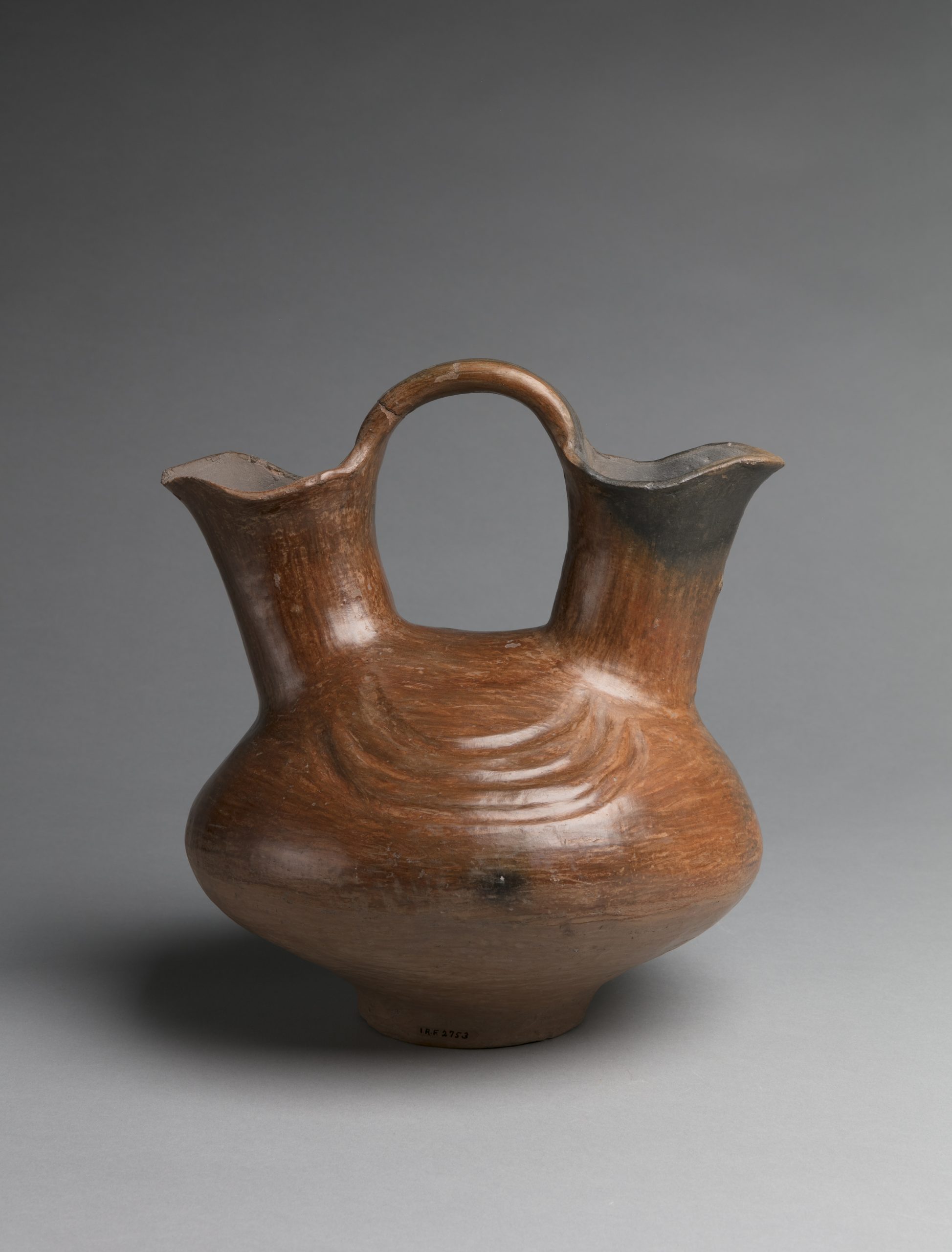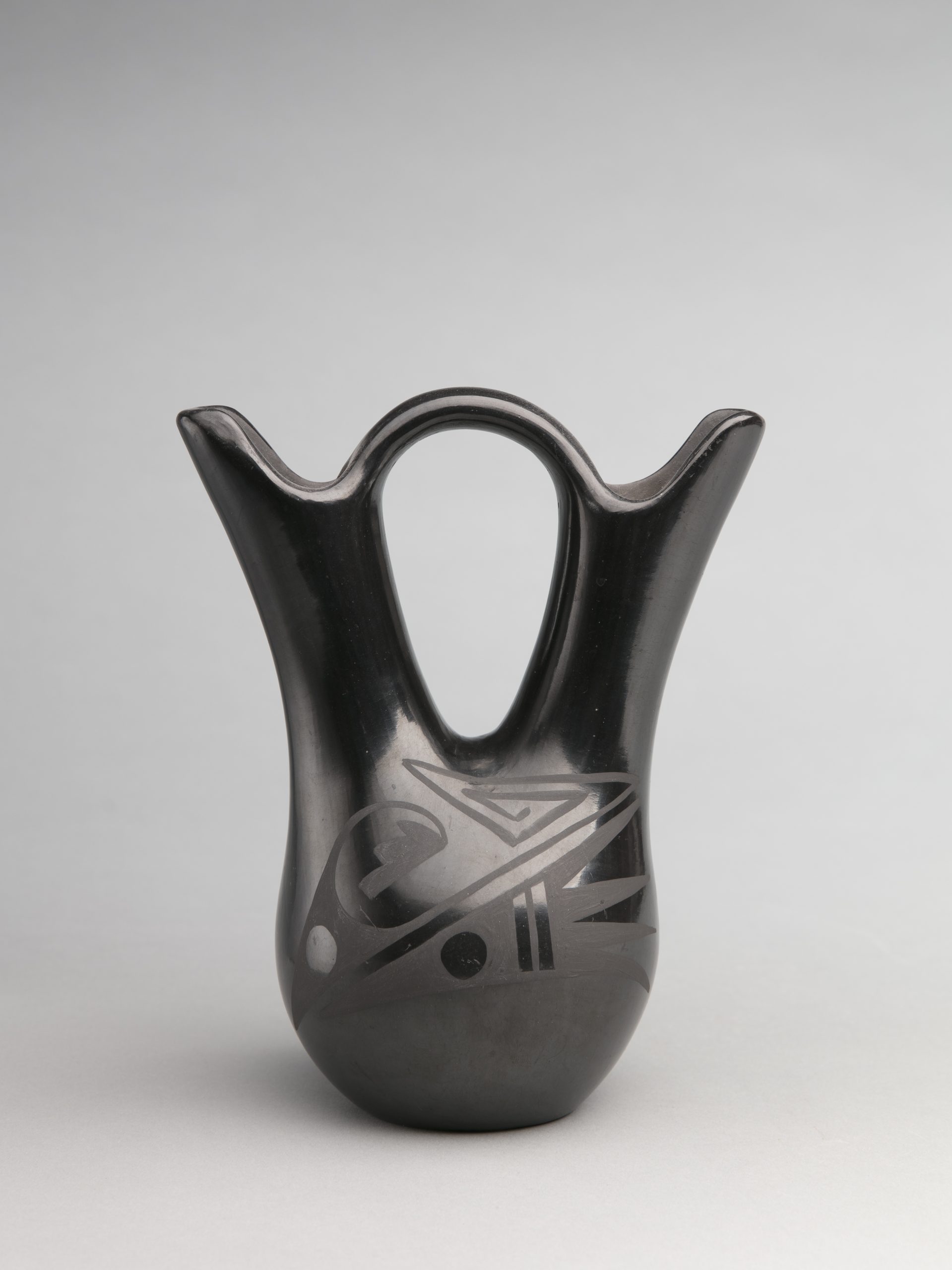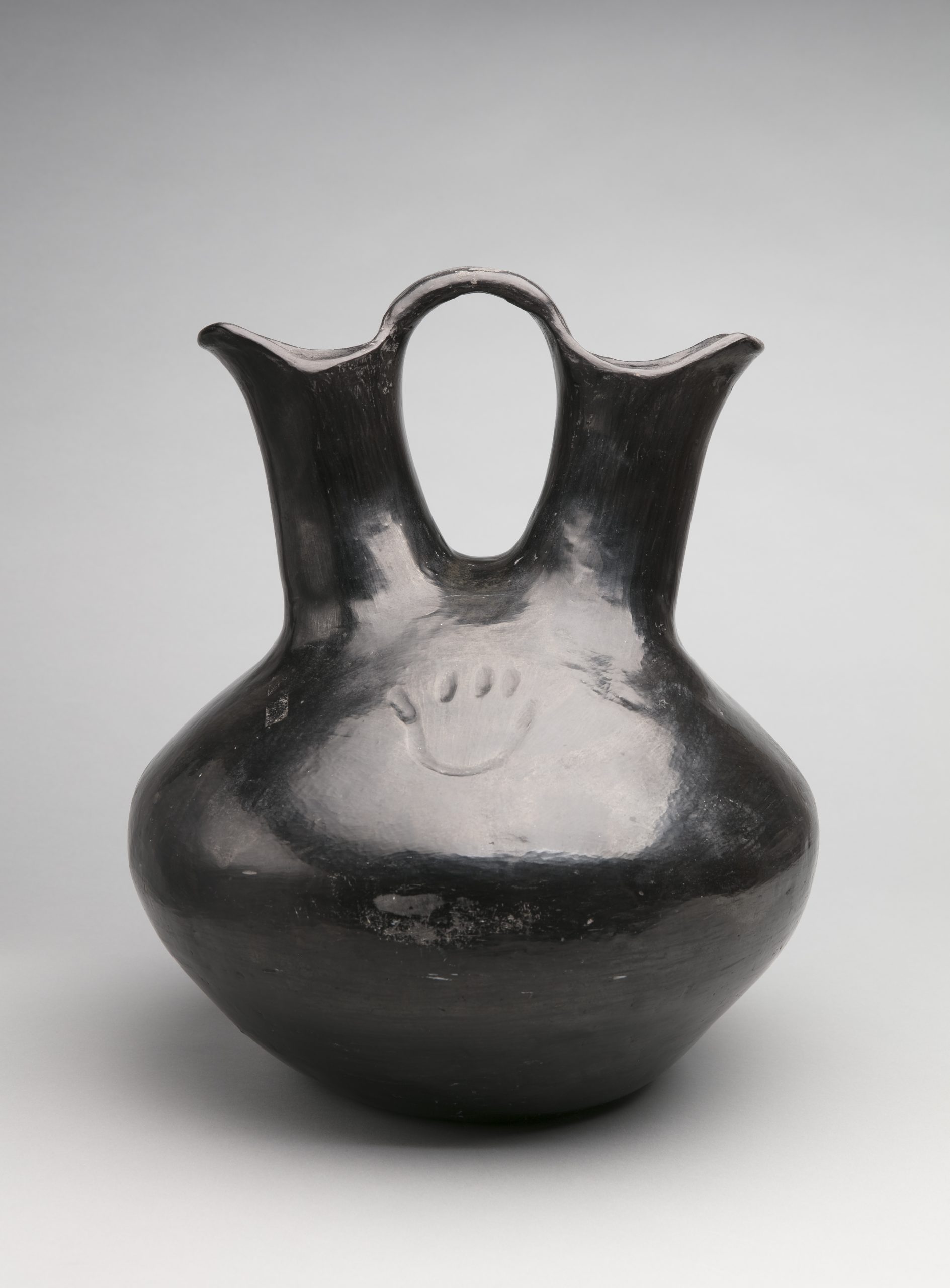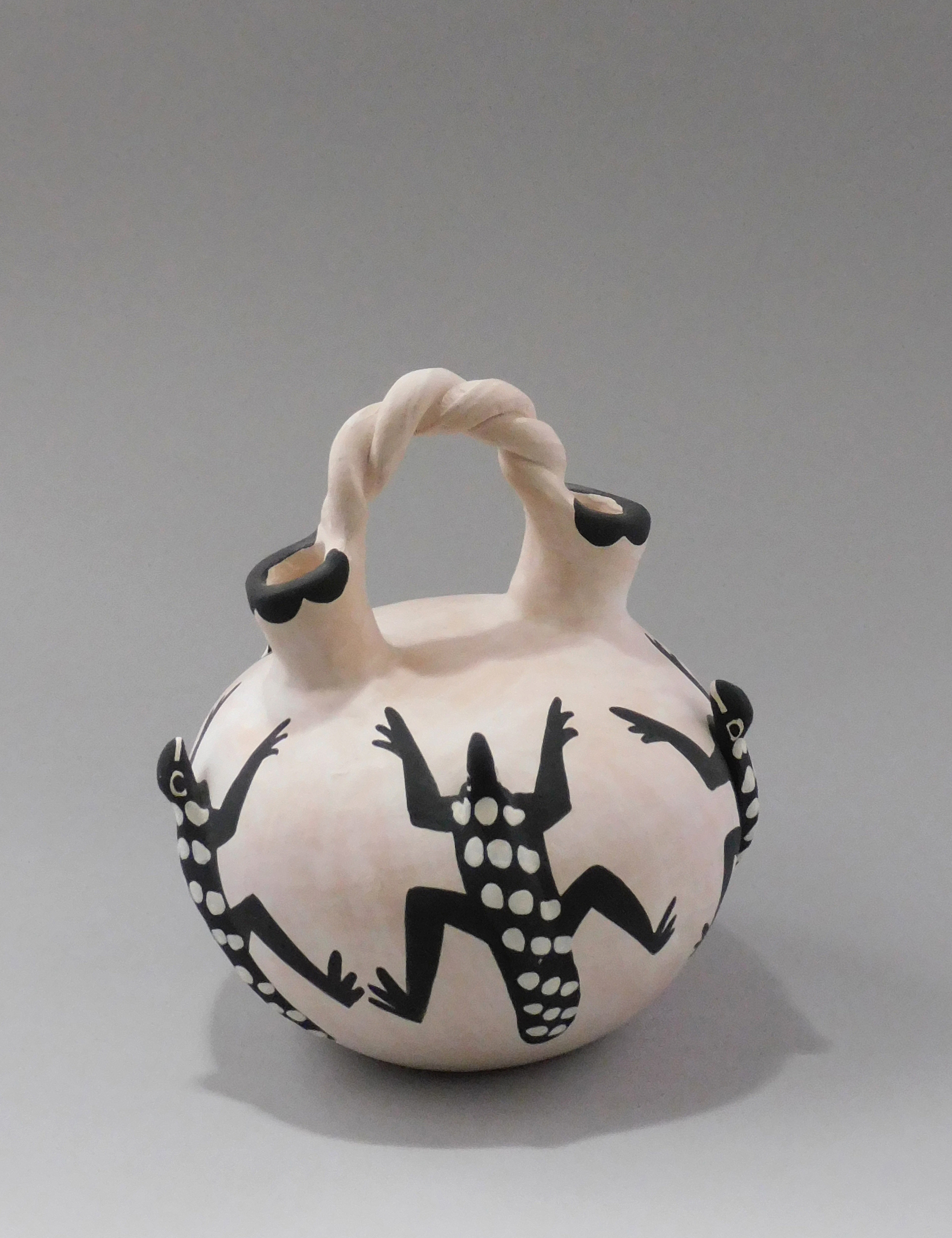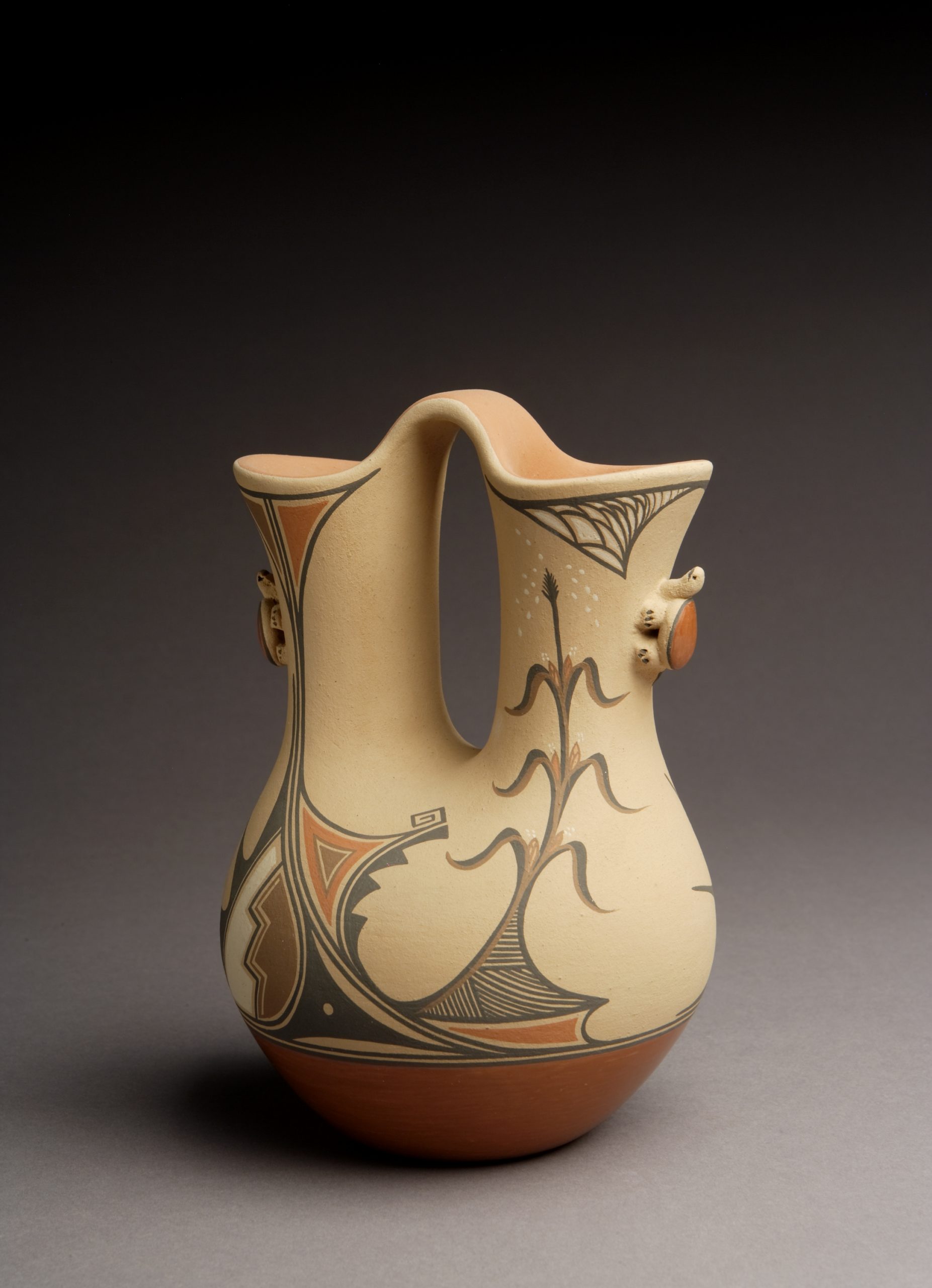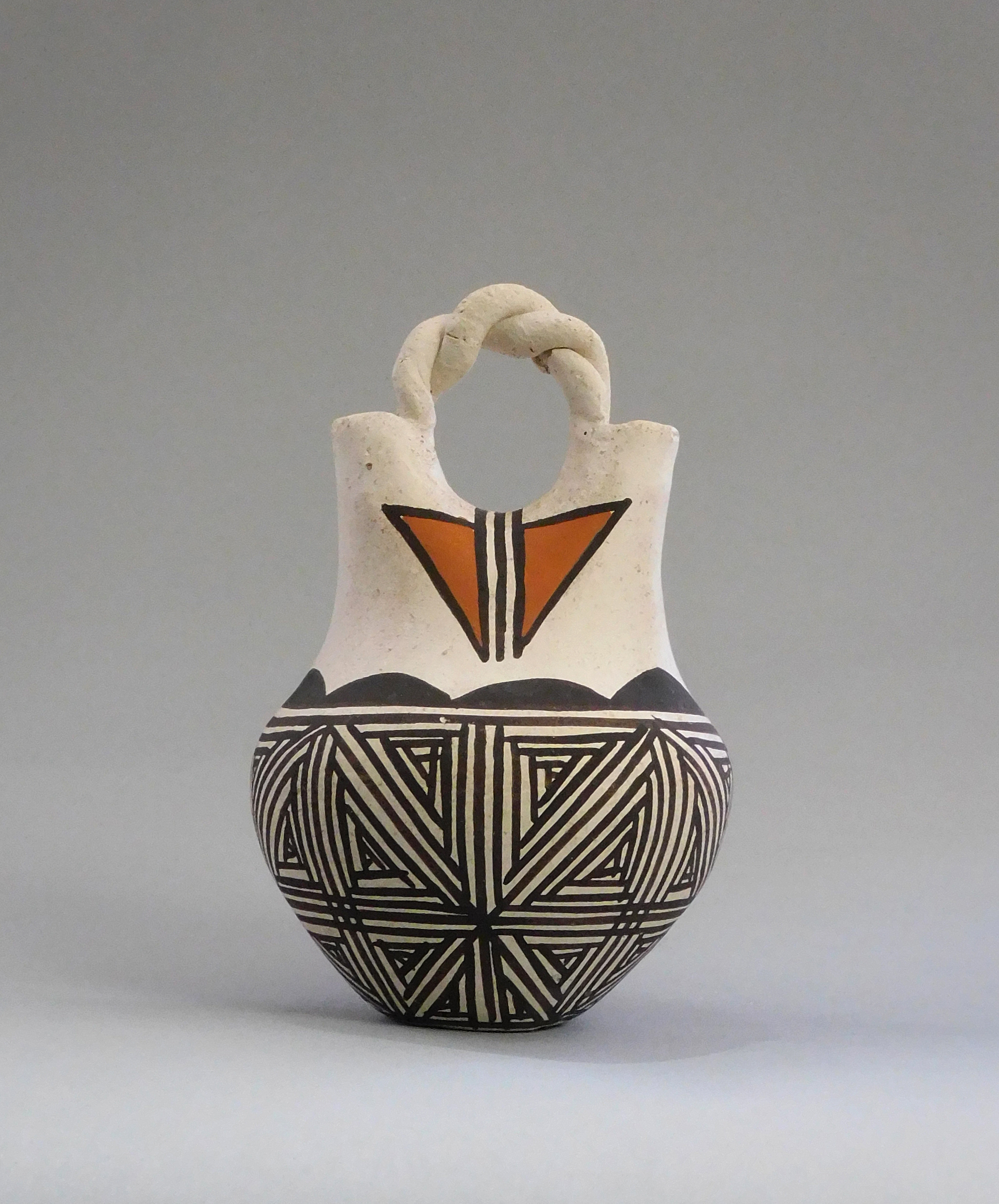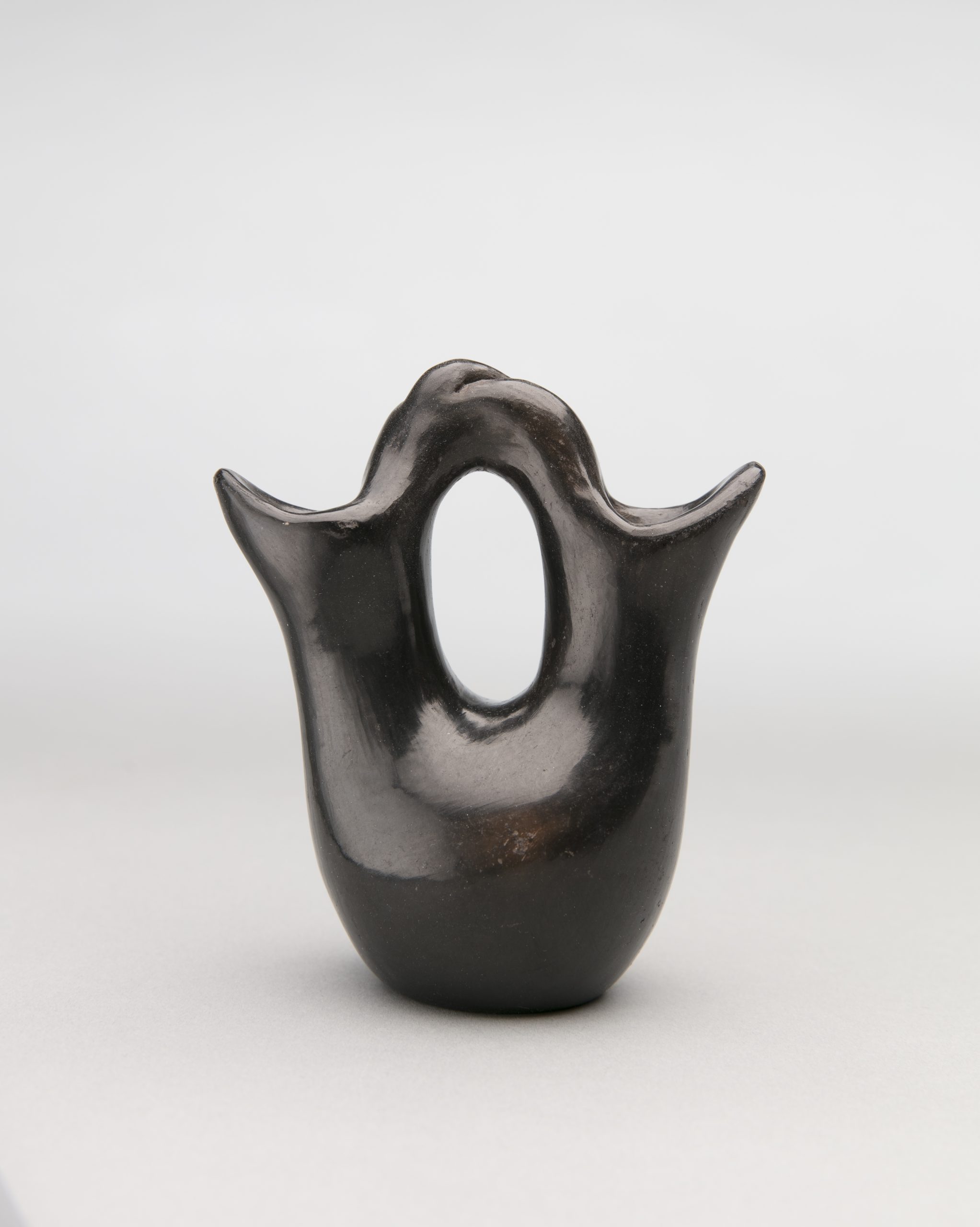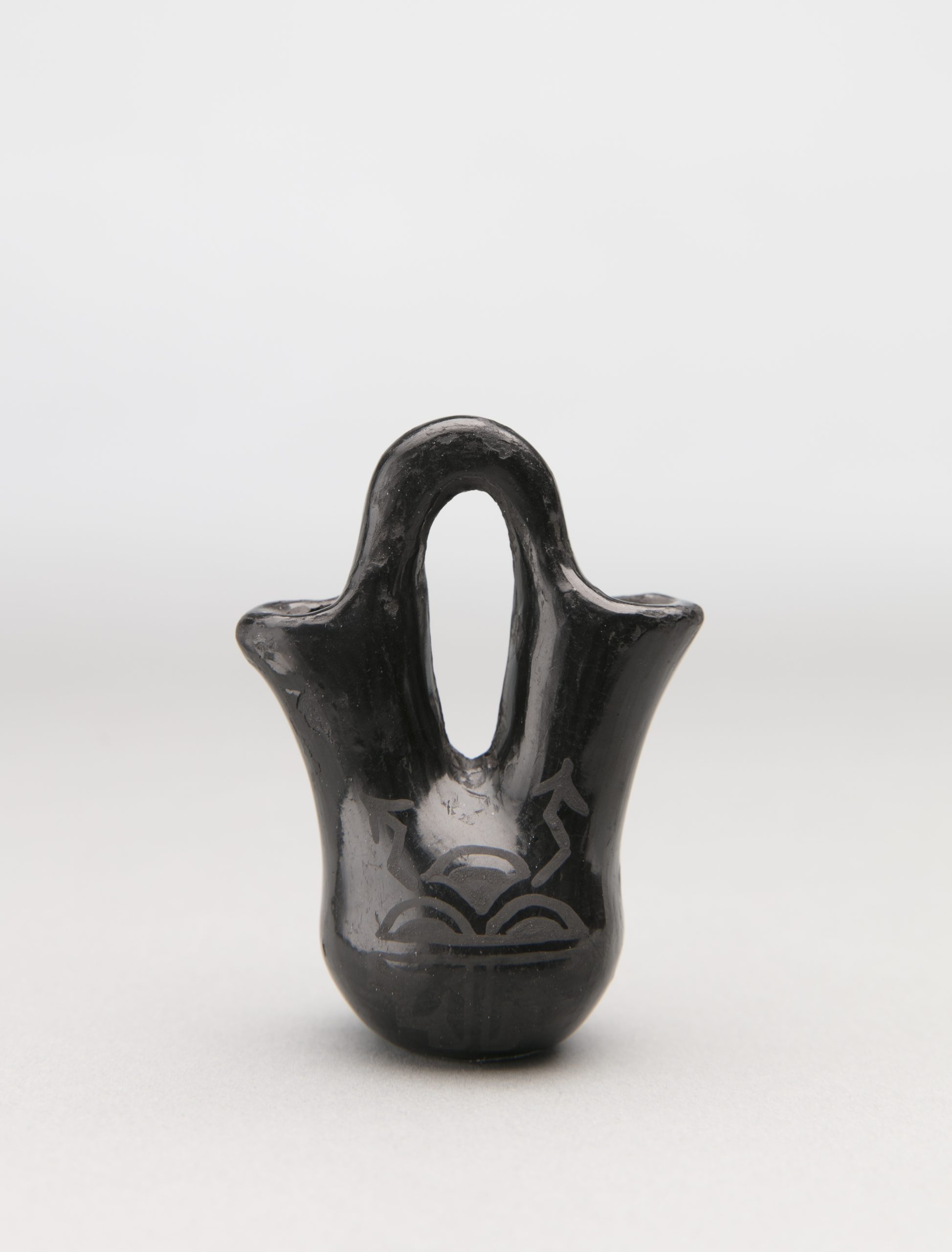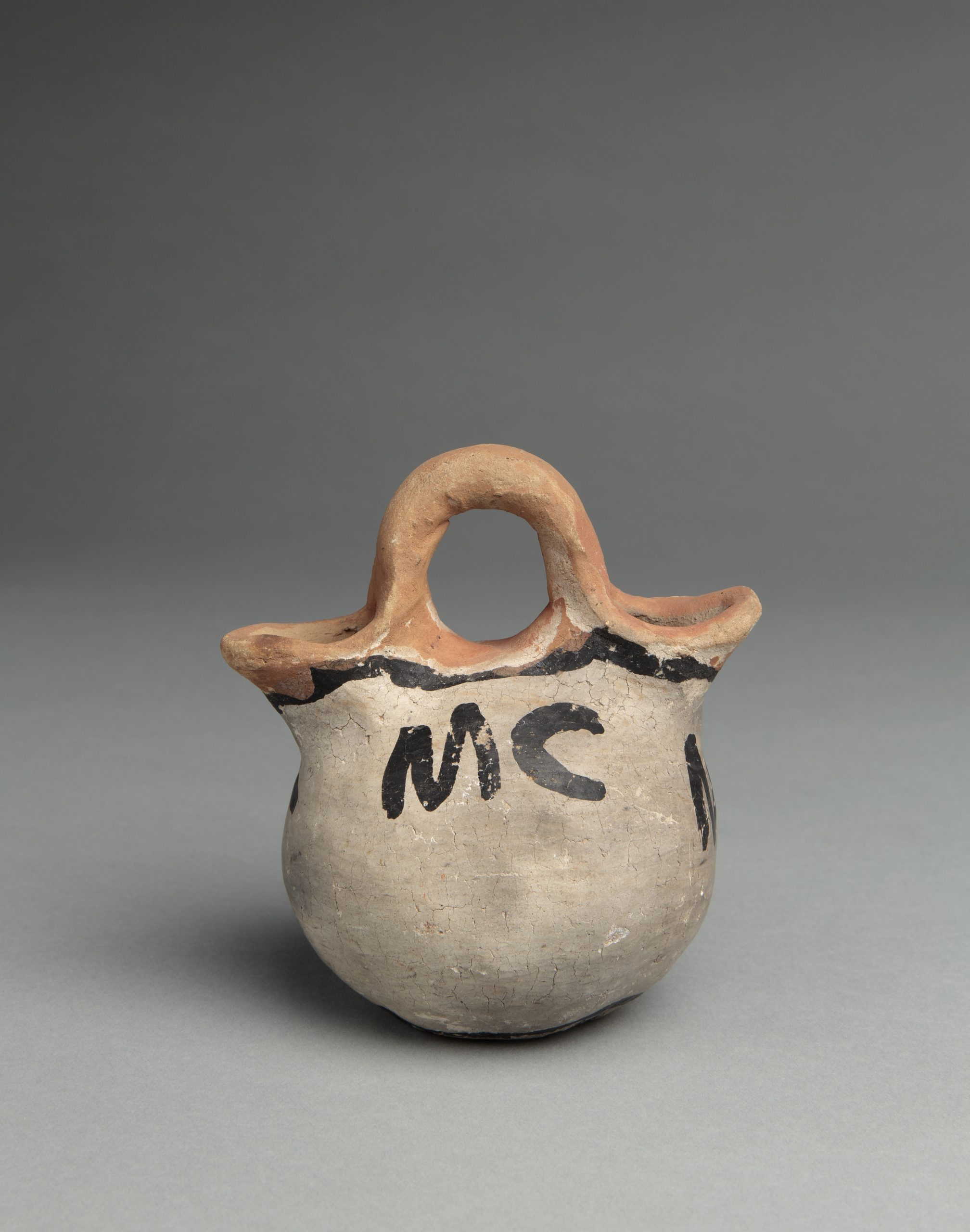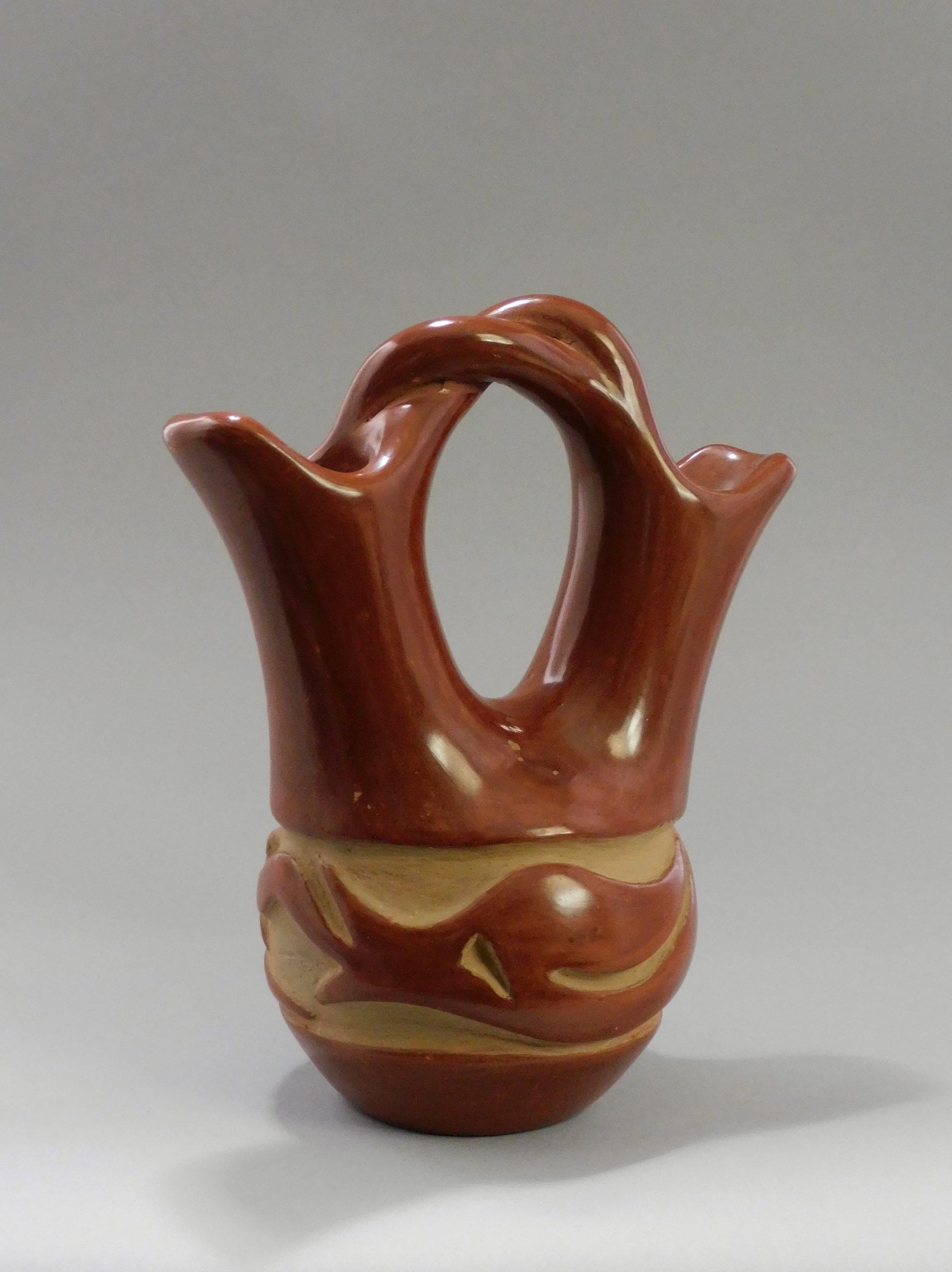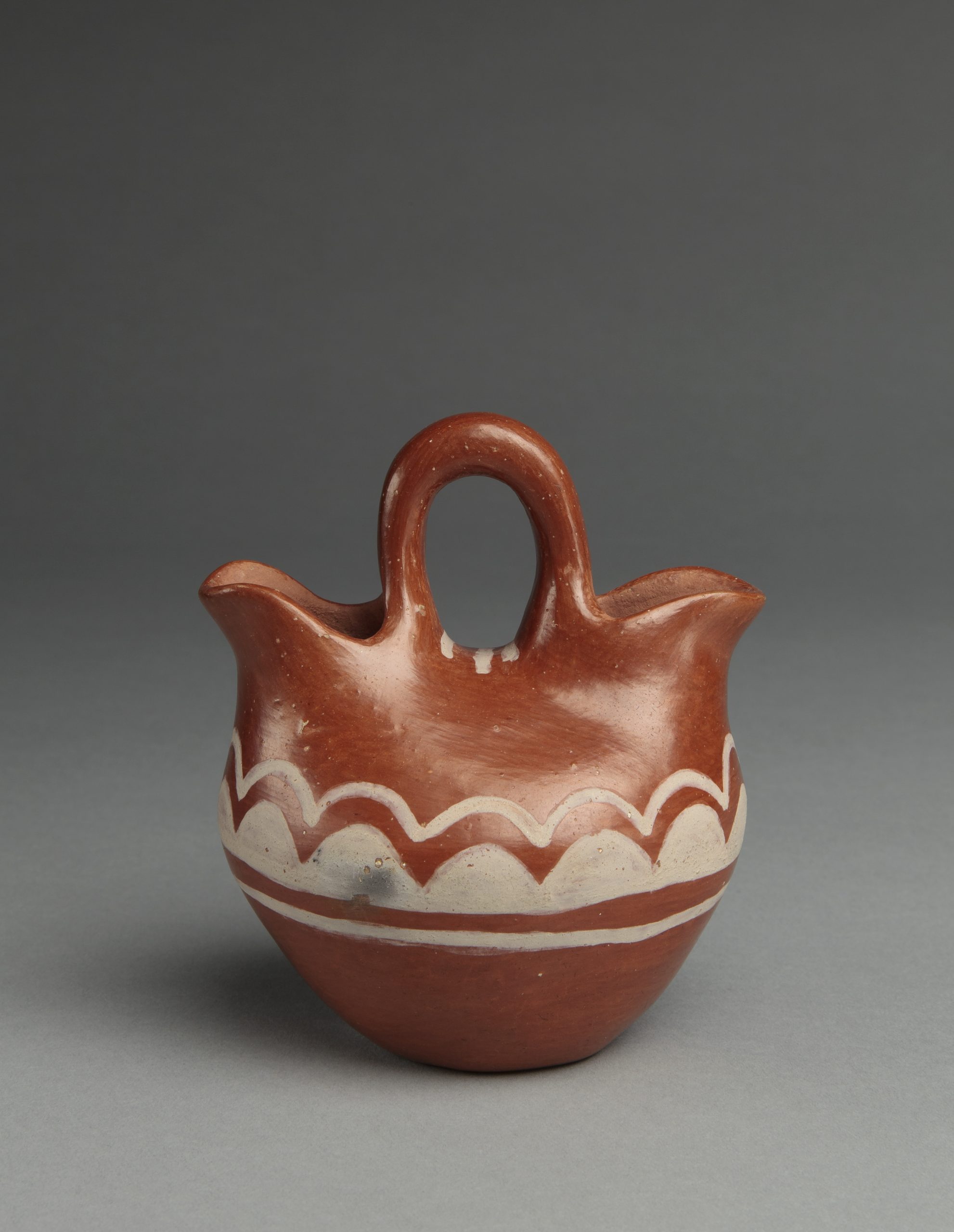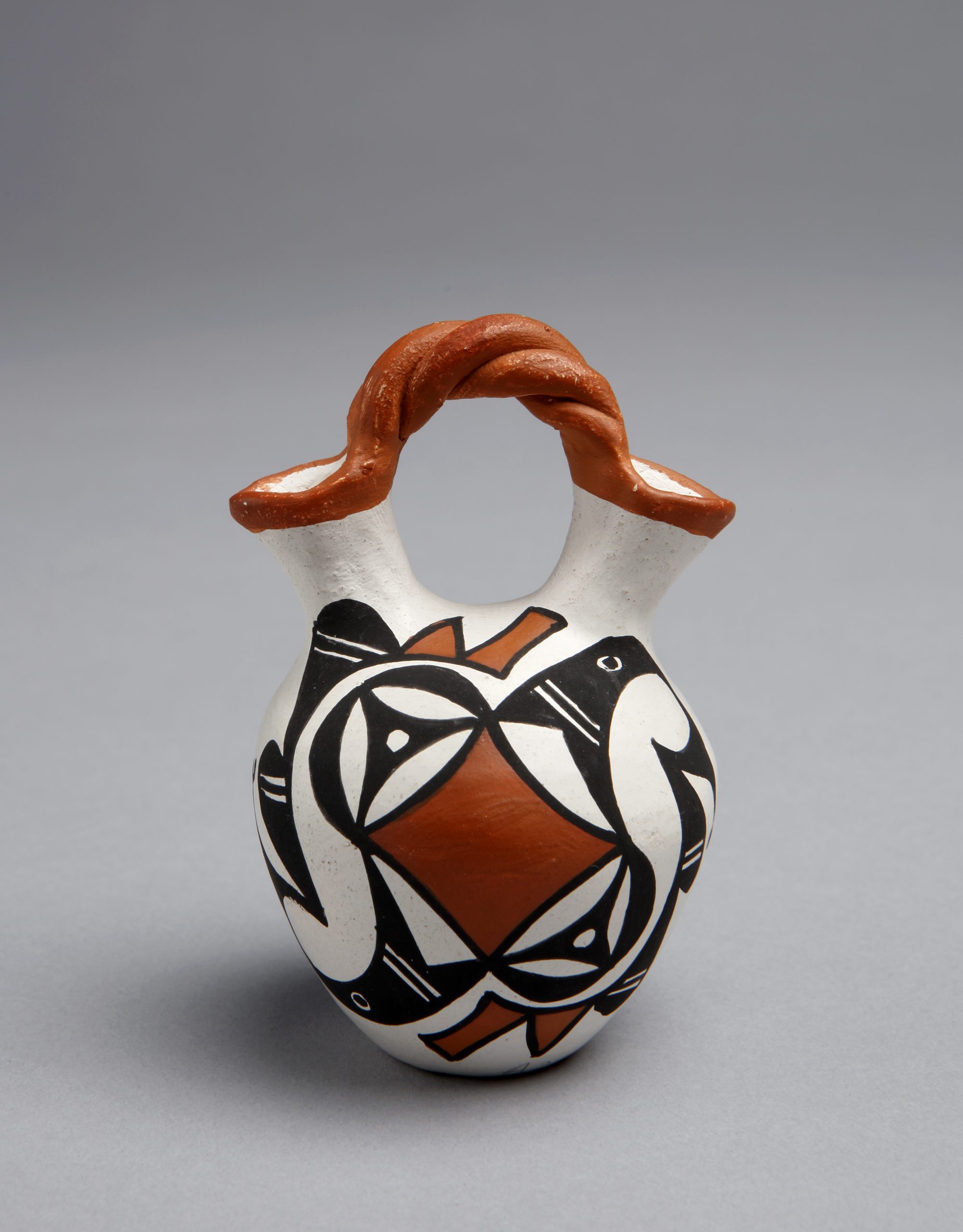Wedding Vases: Creative Expression and Resilience within the IARC Collection
Pottery is an intimate piece of Pueblo culture and has been a form of creativity since time immemorial. Pueblo pottery is the product of a long relationship between Pueblo communities and the land. These pots serve many different roles within the community and culture – some carry water, some disperse seeds, and some are used for ceremonies. As the railroad system developed in the 19th century, some Pueblo people began to adapt pottery to engage with the resulting tourism. Today, Pueblo potters continue to demonstrate their agency through their traditional and innovative pottery-making and by defining how they engage in this new economic environment.
One example of artist agency is seen in wedding vases. A pot style associated with wedding ceremonies, wedding vases are distinct in their shape. Despite this consistency, artists have found diverse ways of making and designing wedding vases to produce unique pieces.
The Indian Arts Research Center at the School for Advanced Research has a collection of wedding vases that display this range of creativity. Spanning the 20th and 21st centuries, surveying the wedding vases’ shapes, designs, and adaptations within the collection provides a look into artists’ diverse choices to better understand Pueblo pottery and resiliency.
Curated by Racquel West, 2021-2022 Anne Ray intern.
THE WEDDING VASE’S CONSISTENCY
There are many steps involved in the making of Pueblo pottery including gathering the materials, building the pot, and the firing process. Within these stages, many elements influence the pot’s shape and designs. Nathan Youngblood, a Santa Clara Pueblo potter, explains that the clay and potter work together; that the shape and designs may come from a potter’s prayers, a mentor’s techniques, the landscape around them, the clay’s intentions, and the potter’s individual signatures.[1]
Each wedding vase has a body, two spouts, and a connection between those spouts. The two spouts reflect their role within some Pueblo wedding ceremonies, representing the two families uniting through the couple’s marriage. These vases can also be enjoyed outside of weddings as beautiful pots for adornment. In both cases, artists have the opportunity to display their creativity and agency within the process while still adhering to the basic characteristics of wedding vases.
While looking at the pieces below, you can ask yourself if there are certain types of objects that are popular in weddings you attend? And, how do you adorn your home?
Wedding jar, Helen Naranjo Shupla (Santa Clara Pueblo), 1970, clay, 8 ⅞” x 5 ⅞”. Cat. no. SAR 1991-11-3. Photo by Addison Doty.
Wedding vase, Artist unknown (Santa Clara Pueblo), 1940-1950, clay, paint, 8” x 6 ¼” x 4 ¼”. Cat. no. SAR.2001-2-2. Photo by Addison Doty.
Wedding Vase, Artist unknown (San Ildefonso Pueblo), 1920, clay, paint, 10 ¾” x 9 ½”. Cat. no. IAF.2544. Photo by Addison Doty.
Wedding vase, Mary Ann Hampton (Acoma Pueblo), c. 1985, clay, paints, 6 11/16” x 3 15/16”. Cat. no. SAR.1994-4-598. Photo by Addison Doty.
Wedding vase, Artist unknown (Santa Clara Pueblo), c. 1900, clay, 8” x 10 ½”. Cat. no. IAF.2140. Photo by Addison Doty.
STYLING WITHIN SPOUTS AND VASE BODIES
“Some artists use the traditional Native clay and methods of their tribe as well as designs – while they may add something of their own designs and ideas, the same goes for style and shape of the vessel. The artist has complete artistic freedom [throughout the] entire process.”
– Sharon Naranjo Garcia, Santa Clara Pueblo potter[2]
The vase’s form provides a surface for creativity to play with structure. While they have similarities that reflect continued teachings of family and community, an individual’s unique ideas still shine through. Look at the different shapes of these pieces’ structure. Some bodies are very bulbous, some have a distinct shape, and others have extra large or small sized spouts. Artists may also use the clay on the pot’s bodies to design protruding shapes.
What is similar between these pieces below? What is different?
Vase, Dextra Quotskuyva Nampeyo (Hopi-Tewa Pueblo), 1973, clay, paints, 13 ¼” x 8”. Cat. no. SAR.1994-4-349. Photo by Addison Doty.
Wedding Vase, Legoria Tafoya (Santa Clara Pueblo), c. 1960, clay, 10 ¼” x 6 15/16” x 4 ¾”. Cat. no. SAR.1993-7-2. Photo by Addison Doty.
Wedding Vase, Eva Histia (Acoma Pueblo), 1986, clay, paints, 16” x 10”. Cat. no. SAR.2021-1-14. Gift of Susan L. Q. Flaherty. Photo by Susan L. Q. Flaherty.
Wedding Vase, Dextra Quotskuyva Nampeyo (Hopi-Tewa Pueblo), before 2017, clay, paints, 4 13/16” x 7 5/16”. Cat. no. SAR.2017-3-14. Photo by Addison Doty.
Wedding vase, Monica Silva (Santo Domingo Pueblo), before 1994, clay, 10 ⅝” x 8 ⅜”. CAt. no. SAR.1994-5-63. Photo by Addison Doty.
Wedding vase, Artist unknown (Acoma Pueblo), 1920-1930, clay, paints, 10 ½” x 8”. Cat. no. IAF.1057. Photo by Addison Doty.
Wedding Vase, Helen Naranjo Shupla (Santa Clara Pueblo), 1960s, clay, 8 7/16” x 5 ⅞”. Cat. no. SAR.1985-14-3. Photo by Addison Doty.
Wedding Vase, Nadine Mansfield (Acoma Pueblo), c. 2010, clay, paints, 5” x 4 ¼”. Cat. no. SAR.2021-1-18. Gift of Susan L. Q. Flaherty. Photo by Susan L. Q. Flaherty.
Wedding Vase, Evelyn Cheromiah (Laguna Pueblo), 1980-1989, clay, paints, 9 7/16” x 7 1/16”. Cat. no. SAR.1994-4-534. Photo by Addison Doty.
Wedding vase, Nicolasa Naranjo (Santa Clara Pueblo), c. 1983, clay, paint, 9 ⅜” x 6 ⅜”. Cat. no. SAR.2021-1-31. Gift of Susan L. Q. Flaherty. Photo by Susan L. Q. Flaherty.
PAINTED AND ETCHED DESIGNS
“Inspiration comes from a lot of these old [pottery] and what I tend to do is take something old, but make it new so it becomes timeless. So nothing’s actually changed, everything stays the same, but it’s new. So that’s how it lives on. Because for us at San Ildefonso, and I’m sure elsewhere, tradition means moving forward, not staying stagnant. Not staying stuck in the past and [being] repetitive, but coming up with your own interpretations and own ideas.”
– Russell Sanchez, San Ildefonso Pueblo potter[3]
Another way potters instill their creativity within wedding vases is through their designs on the pieces. This can be seen in the clay being carved, etched, polished, or designs being painted onto the pot. Some designs are kept on the vases’ bodies and do not extend into the spouts, whereas some have designs on the spouts as well. Decorating the pot can also be done through the firing process. Black pottery is made through oxygen reduction; as the piece is being fired, the potter seals off the airflow of the fire which limits oxygen while burning and then turns the clay black. Some of the black pieces below have carved designs and designs painted with a slip. A slip is a diluted form of clay that can provide a different color and is applied after the pot’s firing. Other pieces are decorated with colored paints.
What do you notice about these designs? How are the designs placed on the vase?
Wedding Vase, Severa Tafoya (Santa Clara Pueblo), before 1973, clay, 8 7/16” x 7 ½”. Cat. no. SAR. 1981-26-14. Photo by Addison Doty.
Vase, Joy Navasie (Hopi-Tewa Pueblo), c. 1965, clay, paints, 8 7/16” x 5 1/16”. Cat. no. SAR.1989-7-309. Photo by Addison Doty.
Wedding Vase, Artist unknown (Acoma Pueblo), 1900-1920, clay, paints, 13” x 11”. Cat. no. IAF.957. Photo by Addison Doty.
Wedding vase, Artist unknown (Acoma Pueblo), 1910-1920, clay, paints, 13” x 9 ½”. Cat. no. IAF.958. Photo by Addison Doty.
Wedding Jar, Artist unknown (Ohkay Owingeh Pueblo), c.1900-1920, clay, 11 ¼” x 24 13/16”. Cat. no. IAF.2753. Photo by Addison Doty.
Wedding Vase, Teresita Naranjo (Santa Clara Pueblo), c. 1970, clay, paint, 7 ⅞” x 6 11/16” x 4 5/16”. Cat. no. SAR.1989-7-314. Photo by Addison Doty.
Wedding Vase, Serafina (Gutierrez) Tafoya (Santa Clara Pueblo), c.1930, clay, 17 11/16” x 14”. Cat. no. SAR.1984-4-9. Photo by Addison Doty.
Wedding Vase, Nadine Mansfield (Acoma Pueblo), c. 2010, clay, paints, 5 ¼” x 4 ¾”. Cat. no. SAR.2021-1-19. Gift of Susan L. Q. Flaherty. Photo by Susan L.Q. Flaherty.
MINIATURE SIZES AS ADAPTION
While tourists began purchasing pottery as they used the railroad system in the 19th and 20th centuries, Pueblo potters chose to engage with this tourism in ways that benefitted them. One example of this is seen in potters making pots smaller, allowing pottery to be easier for tourists to transport.
Santa Clara scholar and potter Tessie Naranjo has written that, during this time period, pottery became influenced by buyers’ preferences and Western ideas of perfectionism.[4] Nathan Youngblood also mentioned that artists are still influenced by the trends of the market today.[5] While Pueblo potters have adapted their pottery with these influences in mind, potters continue to utilize their traditions and innovation within their pieces. Miniature wedding vases, like their larger counterparts, have incredibly diverse styles and designs, and display how artists demonstrate their agency within the tourist economy.
Compare these smaller pots with their larger counterparts – what changes do you see? Are there any similarities of style and design that you notice?
Pueblo potters continue to express a wide range of creativity through their wedding vase designs and styles as pieces for ceremony, art, economic growth, and resiliency.
Wedding Vase, Artist unknown (San Ildefonso Pueblo), c.1975, clay, 3 ¾” x 3 9/16” x 1 15/16”. Cat. no. SAR.1989-7-292. Photo by Addison Doty.
Wedding vase, Artist unknown (Santa Clara Pueblo), before 1994, clay, paint, 2 ½” x 1 15/16”. Cat. no. SAR.1994-5-29. Photo by Addison Doty.
Wedding Vase, Artist unknown (Tesuque Pueblo), c. 1910, clay, paints, 4 ½” x 4 7/16”. Cat. no. IAF.2496. Photo by Addison Doty.
Wedding Vase, Legoria Tafoya (Santa Clara Pueblo), before 1984, clay, paints, 6 ¾” x 5 ¾”. Cat. no. SAR.2021-1-42. Gift of Susan L. Q. Flaherty. Photo by Susan L. Q. Flaherty.
Vase, Dominguita Padilla (Tesuque Pueblo), 1932, clay, paints, 4 ½” x 3 ¾”. Cat. no. IAF.2861. Photo by Addison Doty.
REFERENCES
I would like to extend a big thank you to Sharon Naranjo Garcia and Nathan Youngblood. Both potters were very generous with their time and knowledge and chatted with me about wedding vases, helping me better understand these pots, their history, and their making.
[1] Nathan Youngblood in discussion with the author, January 2022.
[2]Sharon Naranjo Garcia in an email to author, January 2022.
[3] Voices of the Clay, produced by the School for Advanced Research (2020, youtube): minute 21:07-21:35.
[4] Tessie Naranjo, “Pottery Making in a Changing World: Santa Clara Pueblo,” in Expedition 36, no. 1 (1994): 44-50.
[5] Nathan Youngblood (Santa Clara Pueblo potter) in discussion with the author, January 2022.
